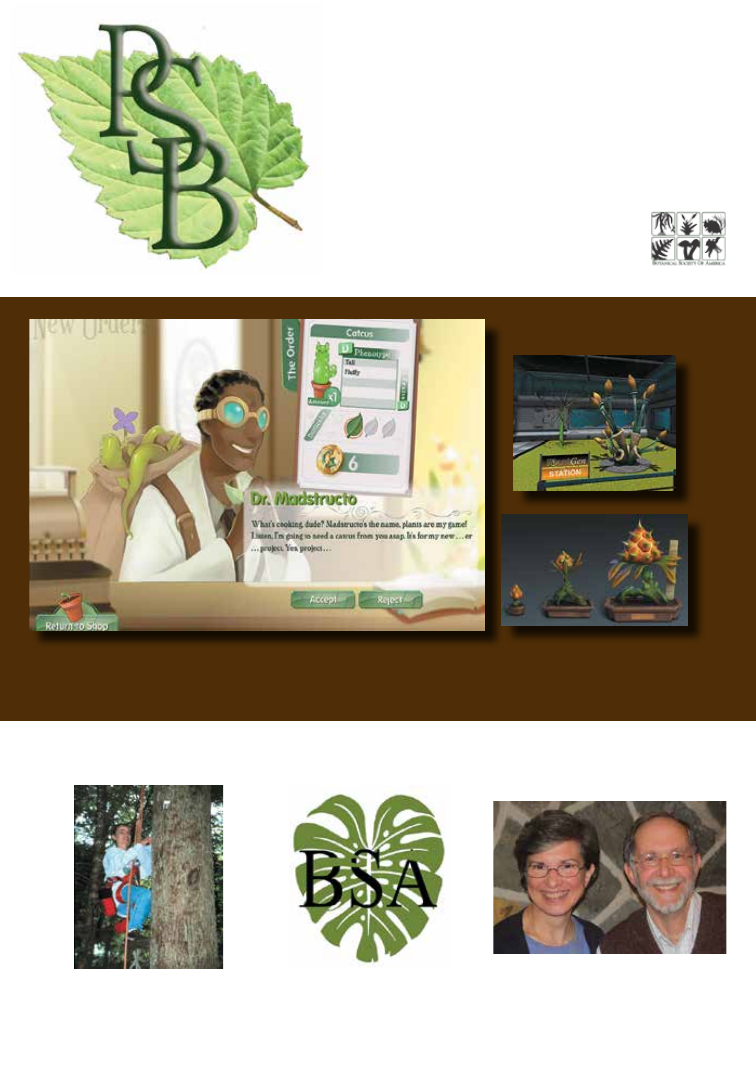
IN THIS ISSUE...
SPRING 2019 VOLUME 65 NUMBER 1
PLANT SCIENCE
BULLETIN
A PUBLICATION OF THE BOTANICAL SOCIETY OF AMERICA
Establishing a BSA Student Chapter... p. 53
CATB Isolation: The True Story, by Jeff
and Jane Doyle... p. 15
Student Team-Based Tree Canopy
Biodiversity Research... p. 28
Botany as a State of Flow
Enhancing Plant Awareness through Video Games

Spring 2019 Volume 65 Number 1
PLANT SCIENCE BULLETIN
Editorial Committee
Volume 65
From the Editor
Melanie Link-Perez
(2019)
Department of Botany
& Plant Pathology
Oregon State University
Corvallis, OR 97331
melanie.link-perez
@oregonstate.edu
Shannon Fehlberg
(2020)
Research and Conservation
Desert Botanical Garden
Phoenix, AZ 85008
sfehlberg@dbg.org
David Tank
(2021)
Department of Biological
Sciences
University of Idaho
Moscow, ID 83844
dtank@uidaho.edu
Greetings,
In this eclectic issue of Plant Science Bul-
letin, we have the story of 2× CTAB iso-
lation, a discussion about the potential of
using video games to promote botanical
education, and a description of canopy re-
search in Great Smoky Mountain National
Park. In the Policy Notes, you will find the
latest information about the Botany Bill,
and the Student Section highlights oppor-
tunities for students.
I am also happy to point you toward our
large assortment of book reviews in this
issue. As always, we are grateful for the
reviewers who take the time to provide a
synopsis and critique of the newest bota-
ny-oriented books, as well as the publish-
ers who make these titles available. If you
are interested in writing a review, the list
of available books can be found at https://
botany.org/home/publications/
plant-science-bulletin.html. We also wel-
come reviews of books that are of interest
but not on our list. For more information,
please contact me at mackenzietaylor@
creighton.edu.
I want to send a special shout-out to our
readers and BSA members who are U.S.
federal employees and who endured the
longest-ever—at least at the time I am
writing this—government shutdown in
January. Your service to botany, science,
and to the United
States is appreciated.
James McDaniel
(2022)
Botany Department
University of Wisconsin Madison
Madison, WI 53706
jlmcdaniel@wisc.edu

2
By Krissa Skogen (Chicago Botanic Garden),
Kal Tuominen (Metropolitan State University),
and Andrew Pais (North Carolina State University
[not pictured]), the BSA PPC Co-Chairs
Public Policy News
In response to the increased interest in science
advocacy, the Public Policy Committee of the
BSA is dedicated to providing resources and
examples of advocacy strategies to help the
scientific community more effectively engage
with policy makers. In 2019, the Plant Science
Bulletin’s Public Policy News will highlight
upcoming legislation, organizations, and case
studies to facilitate greater engagement.
FEATURED LEGISLATION:
REBOOTING
THE BOTANY BILL
If you have been involved or interested in
advocating for the Botany Bill during the past
two years, we need you to spread the word
ENGAGE IN BOTANICAL
SCIENCE ADVOCACY!
and connect with your elected officials in the
116th Congress!
The Botanical Sciences and Native Plant
Materials Research, Restoration, and
Promotion Act (aka the “Botany Bill”) was
introduced to the 115th Congress in the
U.S. House of Representatives (2017; H.R.
1054) and Senate (2018; S.3240). With a new
Congress comes the need to reintroduce
the Bill and a new opportunity for it to
move forward in the legislative process! The
“Botany Bill” will be reintroduced in the
116th Congress in both the House and Senate
once co-sponsors are identified, ideally in
early 2019. In order for the Bill to make it
to committee, it will need broad bipartisan
support in both the House and the Senate.
Consider contacting your elected officials
and asking them to co-sponsor the Bill!
We will need all the support we can get—
your efforts are needed and valued!
Visit https://botanybill.weebly.com/ for
resources to guide your advocacy efforts,
for information on the new version of the
Botany Bill, and to sign up for updates on
the Bill!
SOCIETY NEWS

PSB 65 (1) 2019
3
FEATURED ORGANIZATION:
THE PLANT
CONSERVATION ALLIANCE
The Plant Conservation Alliance (PCA) is a
public-private partnership of organizations
that share the common goal of protecting
native plants by ensuring that native plant
populations and their communities are
maintained, enhanced, and restored. The
partnership includes 12 U.S. Federal Agency
Members (the Federal Committee) and
nearly 400 Non-Federal Cooperators (the
Non-Federal Cooperators Committee),
which is comprised of state agencies and
private organizations interested in native
plant conservation in the United States.
PCA Members and Cooperators work
collaboratively to solve the problems of
native plant conservation and native habitat
restoration, ensuring the sustainability of
ecosystems in the United States. The depth and
strength of PCA lies in the scientific expertise,
networking, and ability to pool resources to
protect, conserve, and restore our national
plant heritage for generations to come.
In 1995, PCA developed the National
Framework for Progress in Plant Conservation
(https://www.blm.gov/sites/blm.gov/files/
programs_natural-resources_native-plant-
communities_national-seed-strategy_pca_
Framework.pdf). This Framework is intended
to provide a coordinated approach to plant
conservation in the United States. The National
Framework consists of six broad strategies and
outlines supporting goals and actions to guide
efforts for implementing a national plant
conservation strategy at national, regional,
and local levels.
Cooperators are invited to attend meetings
of the PCA’s Federal Committee as observers,
participate in informal open forums with
the PCA Federal Committee, and participate
in PCA Working Groups. Cooperators also
receive regular communications that facilitate
participation in Non-Federal Cooperator
Committee efforts to raise awareness about the
importance of native plant conservation. In
addition, the PCA holds bi-monthly meetings
as an open forum for anyone interested
in working in plant conservation. The
meeting takes place in the Washington, DC
metropolitan area and is available remotely
as a live webinar. Attendees use a roundtable
format to share relevant events and discussion
on work related to plant conservation, and each
of the PCA working groups and committees
provides ongoing updates. Regular attendees
include representatives from PCA Federal
agencies and from cooperating organizations.
However, anyone is welcome to attend the
meetings.
Get Involved with the PCA!
Join the PCA listserv to learn about upcoming
meetings, receive announcements, and follow
discussions on native plant conservation:
http://lists.plantconservation.org/mailman/
listinfo.
Visit http://www.plantconservationalliance.
org/cooperators to find out if your organization
or agency is part of the PCA.
The schedule for upcoming meetings
can be found at http://www.
plantconservationalliance.org/meetings.
Follow the PCA on Facebook at https://www.
facebook.com/PlantConservationAlliance/.

PSB 65 (1) 2019
4
In Memoriam
HUGH DANIEL WILSON
(1943–2018)
Hugh Daniel Wilson was born in Alliance,
Ohio, to Fern and Elvin Wilson on August 15,
1943 and died November 5, 2018.
He grew up in Alliance and graduated from
Alliance High School in 1961. He was a
running back on the AHS 1958 Football State
Championship team and held a track record
at the Ohio State Relays that lasted for nearly
20 years. Hugh was elected to Alliance High
School Athletic Hall of Fame in 2000.
Sargent Hugh Wilson was honorably
discharged from the United States Air Force 1964-68
with an Air Force medal of Commendation
for Meritorious service in Vietnam.
After returning from the service, Hugh
completed a Bachelor of Arts (Biology) in
1970 and Master of Arts (Botany) in 1972 at
Kent State University, Kent, Ohio. Thesis: “The
Vascular Plants of Holmes County, Ohio”.
Hugh received his Ph.D. in Botany and
Anthropology 1973-1976 from Indiana
University, Bloomington, Indiana Dissertation:
“A biosystematic study of the cultivated
chenopods (Quinoa) and related species”.
After earning his Ph.D., Hugh was a visiting
professor on the faculty in the Department of
Botany at the University of Wyoming, Laramie,
Wyoming. Hugh had full responsibility for a
five-week Science Camp offering field Botany.
In 1977, Dr. Wilson joined the faculty at
Texas A&M University, College Station, Texas
(College of Science), Department of Biology.
He taught Taxonomy of Flowering Plants, Field
Systematic Botany, and Economic Botany until
he retired in 2011 as Professor Emeritus.
Dr. Wilson was known for the study of the
floras of Ohio and Texas, with focus on
conservation of rare species and habitats,
and for his ethnobotanical research and early
molecular work on Lagenaria, Cucurbita, and
Chenopodium. His enthusiasm for taxonomy,
ethnobotany, floristics, conservation, and
specimen digitization inspired many of his
students to become botanists or pursue related
fields, and I am lucky to count myself among
them.
Dr. Wilson was the curator of the TAMU
Herbarium (now combined with Texas A&M’s
Tracy Herbarium, TAES) and was an early,
visionary promoter of specimen digitization,
herbarium data standards, online collections
browsers, and regional consortium building—
many years before these ideas became widely
embraced and adopted. He was instrumental
in the creation of one of the earliest online

PSB 65 (1) 2019
5
herbarium specimen browsers (for TAMU
and TAES), and provided leadership for both
iterations of the region’s herbarium consortia
(first, the Digital Flora of Texas Consortium,
and later, the Texas-Oklahoma Regional
Consortium of Herbaria (TORCH)). Wilson’s
insistence that botanical data should be
digitized so they could be easily shared and
updated, and then eventually combined and
mined for research—long before Big Data
was a thing—made him a pariah, in his own
opinion. In my opinion, he is one of the giants
upon whose shoulders many of us now stand.
Hugh was given the Edmund H. Fulling
Award, Society for Economic Botany,
1981, Fellow American Association
for the Advancement of Science 1990.
He received support for research from
the National Science Foundation, U.S.
Department of Agriculture, and National
Geographic Society.
Dr. Wilson was a member of the American
Association for the Advancement of Science,
the Botanical Society of America, the
American Society of Plant Taxonomists, and
the Society for Economic Botany.
Hugh is survived by his wife, C. Toni (Favazzo)
Wilson, College Station, TX; son, Quentin F.
Wilson, Portland, Oregon; brother, Gary L.
Wilson, Los Angeles, CA., nephews, Derek M.
Wilson, Dallas, TX, C.D. Wilson, Sachem, CT;
and their children.
In lieu of other forms of commemoration,
please take the time to accompany your
students in their fieldwork, or invite them to
accompany you in yours.
(Dr. Wilson’s obituary was published in the Alli-
ance Review on 10 November 2018. We present
it here with additions by Amanda K. Neill.)
LANNY FISK
(1944–2018)
Dr. Lanny Herbert Fisk (1944-2018), beloved
brother, father, and friend, left the Earth and
life he loved on July 19, 2018. He resided in
Grass Valley, California. Lanny was born to
Paul J. and Mildred (Courser) Fisk on February
24, 1944. He graduated from Vestaburg
High School in 1962. In January of 1967 he
married Carolyn McDowell of Detroit, MI.
He was drafted into the U.S. Army and served
as a Medical Specialist at the U.S. Pentagon
from 1967-1969. Following his honorable
discharge, he moved to Berrien Springs,
MI where he completed an undergraduate
degree at Andrews University in 1971. After
earning his PhD in Biology, with emphasis
on Paleobotany, from Loma Linda University
(LLU) in Loma Linda, CA, he taught at
Walla Walla College (WWC) in Walla Walla,
WA. He then pursued postdoctoral studies
in Petroleum Geology at Michigan State
University.

PSB 65 (1) 2019
6
Life-long research took Lanny around the
world, but his favorite was conducted at
Yellowstone National Park (YNP) where he
had graduate students working under him
doing research on the petrified forests of
YNP. His research, often in collaboration
with valued colleagues, has been published
in several journals, including but not limited
to The Journal of Paleontology. Geological
Society of America (GSA) was the first
professional organization he joined and went
on to become a member of the Paleontological
Society as well as too many others to name.
He held teaching positions at WWC, LLU,
and most recently, American River College
in Sacramento, CA. While at LLU, he and
Dr. William J. Fritz incorporated F & F
GeoResource Associates, Inc. In 1982 Lanny
created, as the Senior Paleontologist and
Chief Executive Officer, the consulting firm
of PaleoResource Consultants, DBA of F &
F. In 1993 he was appointed by the Governor
of Oregon to serve on the Board of the
Oregon Department of Geology and Mineral
Industries, which he did through 1998.
Lanny was very active in AASP-The
Palynological Society over the past many
years. He was President of the Society in 2014;
prior to that he was President-Elect (2013)
and then Past-President (2015). While he
was President-Elect he hosted and organized
the 2014 AASP-TPS Annual Meeting in San
Francisco. Lanny fulfilled many wishes of
hosting that meeting in San Francisco, with
a ’60s theme t-shirt, the venue in downtown,
and a geologically oriented field trip to the
wine country. Over the past decade Lanny was
ever present at AASP-TPS annual meetings,
giving presentations, participating in board
meetings, and participating in other Society
activities.
Right up until his passing, Lanny was
organizing projects and studies involving
fieldwork and travel. He was full of incredible
energy and enthusiasm. He had just been
talking with Joyce Lucas-Clark about a new
project on the California Eocene-Oligocene
stratigraphic problems, and had longer-
term plans for working on the Chalk Bluffs
microflora. Appropriately, Lanny passed away
while working at his computer in the office
late at night. He had dreams of projects right
up until the time of his death. No one knew
the extent of his health problems other than
his knee replacements. Despite those surgeries
and normally bringing up the rear with Joyce
on hikes, he thoroughly enjoyed fieldwork.
Throughout his professional career, Dr. Fisk
was a lecturer, teacher, and mentor to many
in the geology and paleontology community.
In 1996 Lanny married Tami Wanner. Their
children are Daniel (21), Michael (19), and
Dessa (16), who all live in the Sacramento
area. Lanny’s family also includes his sisters,
Paula Fardulis of Carlsbad, CA, and Susan
Brantley of Vestaburg, MI. Lanny had valued
relationships with many cousins, nieces and
nephews, great nieces and great nephews, who
tolerated the teasing and practical jokes that
came along with his wit. Those of us who were
close to him have lost a very good friend.
-Joyce Lucas-Clark and Thomas Demchuk
Excerpts taken from Legacy.com
Reprinted from the AASP – The Palynological
Society Newsletter 51 (4): 15-16.

PSB 65 (1) 2019
7
NEIL ARTHUR HARRIMAN
(1938–2018)
Neil Arthur Harriman died at home on
December 7, 2018 after a rather lengthy
decline in his health.
Neil was born on August 1, 1938 in St.
Louis, Missouri, the only son of Ruth and
John Harriman. He grew up in St. Louis along
with his older sister, Ruth. Neil received his
Bachelor of Arts from Colorado College,
Colorado Springs, Colorado, in 1960, followed
by a Doctor of Philosophy from Vanderbilt
University in Nashville, Tennessee, in Biology
in January 1965.
While at Vanderbilt, Neil met Bettie Ralph and
they were married on July 13, 1963. Together,
they moved to Oshkosh, Wisconsin, in
September of 1964 when Neil joined the
Biology Department faculty at University of
Wisconsin Oshkosh (UWO), primarily to
teach botany classes and do plant taxonomy
research. Neil remained at UWO until his
retirement in May 1998.
Neil was a dedicated teacher and found
great satisfaction not only in teaching about
botanical information, but helping the students
learn to be life-long learners. It gave him much
pleasure that three of his students went on to
get their own PhDs in Botany: Robert Jansen,
Bruce Parfitt (deceased), and Melanie DeVore.
His research work of collecting, identifying,
and conserving plants was also a pleasure to
him. When Neil arrived on campus in 1964,
the herbarium facility in Halsey Science
was barely more than a room with cabinets
waiting to be filled with dried, identified,
and properly labeled plants, arranged in a
systematic fashion. Today it houses almost
125,000 specimens from around the world,
including over 70 type specimens; three
of these document species named in Neil’s
honor: Flyriella harrimanii, Lundellianthus
harrimanii, and Phyllanthus harrimanii. After
Neil’s retirement, the university named the
herbarium in his honor. The Neil A. Harriman
Herbarium contains not only plant specimens,
but Neil’s extensive personal botanical library
as well.
Neil belonged to numerous botanical societies
during his career, including American Society
of Plant Taxonomists, for which he served a
three-year term as Secretary and Program
Chairman, and the International Association
for Plant Taxonomy. He served as Editor
of The Michigan Botanist for many years,
and as a reviewer and author in the Flora
of North America project of the Missouri
Botanical Garden. Over the years he published
numerous scientific articles in the journals of
these societies.
During his 34 years as a member of the UWO
faculty, Neil received a number of awards and
recognitions. In 1973–1974, he was given the
Citation as an Outstanding Teacher. In May
1986, Neil was named a John McNaughton
Rosebush University Professor for Excellence

PSB 65 (1) 2019
8
in Teaching and Professional Achievement.
In 1993 he received the UWO Endowment
for Excellence - The TRISS Endowed
Professorship.
When Neil retired in 1998, he was named
Professor Emeritus of Biology and
Microbiology at UWO by the Board of Regents
and continued to work in the herbarium as
long as his health allowed.
Neil’s joy for editing the written word extended
beyond botany, as did his willingness to “help
out” when needed. During his retirement,
Neil joined his wife Bettie as co-editors for
the quarterly journal of the Wisconsin Society
for Ornithology from 2003 to 2014. He also
contributed his editing skills to the production
of the Atlas of the Breeding Birds of Wisconsin, a
600-page book published by the Wisconsin
Society for Ornithology in 2006.
The essence of Dr. Neil A. Harriman is
perfectly stated by one of his graduate
students, Tom Eddy: “Forty years ago, as a
young graduate candidate at the University of
Wisconsin Oshkosh, I was encouraged by Dr.
Neil A. Harriman to conduct a systemic study
of the vascular flora of Green Lake County. My
thesis research and association with Neil
resulted in a profound change in my life
trajectory, both personally and professionally.
“Besides our independent plant collecting,
Neil and I participated in numerous botanical
outings organized by the Botanical Club
of Wisconsin. Neil’s taxonomic knowledge
was encyclopedic. He exercised a superlative
command of language and proper use of
grammar. Whether in lecture or private
conversation, he could turn what first
appeared to be a collection of unrelated facts
into a relevant lesson, frequently accompanied
by humorous euphemisms.
“Neil was an unpretentious and modest
person, preferring not to draw attention to
himself. In 2009, the herbarium which Neil
founded in 1964, was dedicated in his honor:
the Neil A. Harriman Herbarium. While such
an honor might offer one an opportunity to
grandstand, Neil chose not to speak at this
ceremonious tribute.
“The natural world was held in reverence
by Neil. Whether botanizing a natural area,
roadside right-of-way, or parking lot, his eye
was trained on the ground. Besides collecting
new plant records, Neil regularly collected and
properly disposed of someone else’s litter.
“Neil gifted generously to his local animal
shelter. He held a tender spot for cats and dogs
waiting to be adopted. On numerous occasions
I witnessed a similar mindfulness by Neil
toward other peoples’ lives whose unfortunate
circumstances were less than ideal. He was
generous, big-hearted and aspired for the
common good. For all this, I owe Neil a debt
of gratitude for his mentorship and unflagging
friendship.”
Neil is survived by his wife Bettie and many
friends who offered comfort and assistance
with his care. His final week was under the
excellent care of Aurora At Home hospice
care, which gave much physical support and
comfort to Neil in a most experienced and
professional manner while at the same time
providing an easy emotional and caring
support for Bettie.
-Thomas G. Lammers, Ph.D., Professor Emeri-
tus, Department of Biology and Microbiology,
University of Wisconsin Oshkosh

PSB 65 (1) 2019
9
Heather Cacanindin was named the BSA
Executive Director in March 2018, after a
competitive search to replace Bill Dahl, who
retired in October 2017. Prior to taking over
the reins of the Society, Heather served as the
Director of Membership and Marketing for the
BSA, the Society for the Study of Evolution, and
the Society for Economic Botany for over 10
years.
Why did you want to be the Executive
Director of the BSA, and what makes you
excited to come to work?
I have spent my entire career in association
and nonprofit work. I love working for
organizations that are truly mission-driven
and making an impact on the communities
that they serve. After ten years at the BSA,
I felt that I had a deep understanding of the
organization, its culture, and our staff and our
members’ needs. BSA does such a great job in
serving its members in every career stage, and
our members are doing fantastic and exciting
research and outreach. It is invigorating to
know that we are all here to nurture scientific
discovery, provide professional development
opportunities, and pave the way for the next
generation of botanical scientists. I find that
there are so many dedicated members and
leaders in this organization, and that makes
coming to work each day really worthwhile
and fulfilling. I know the rest of our staff feels
the same way. And also, our BSA staff is just
fantastic to work with!
What is the most surprising or challenging
thing you have encountered in your first
year as Executive Director?
It was surprising to me just how long it took
to get up to speed in an organization that had
been my home for several years. There were
still so many aspects of our business that I had
only tangentially been exposed to. I realized
quickly that there was still so much for me to
learn at the BSA, and that was challenging, a
little scary, and exciting all at the same time.
In what way is serving in this role different
than you imagined?
It’s hard for any organization to transition
from a long-time Executive Director to a new
leader. I don’t think I realized just how much
our Board, members, and staff were looking
to me to set the tone and direction for the
next phase of BSA’s evolution. I also realized
quickly that it was hard for me to let go of
some of my previous work that was familiar
and comfortable in favor of some of the new
initiatives and work on my desk as Executive
Director. Luckily, with the help of our staff,
leadership, and a terrific new Membership
Manager to fill my previous role, I have been
able to make the pivot.
5 Things About Your Executive Director

PSB 65 (1) 2019
10
Who is a person who has influenced and/or inspired you in your work?
I had a fantastic mentor at the United Soybean Board, when I worked there several years ago.
She taught me to always put forth my best effort, do my research, and really listen to my leaders
and constituents. I also learned from her that sometimes you have to speak your mind and
stand up to your leadership if they are getting off track or engaging in mission-creep. Running
an association is a partnership between the leadership and the staff, but the direction of the
organization really rests with the members and the mission of the organization. She also taught
me that it is important to continue to sharpen my skills and support my staff in their own
professional development. Thanks, Janice!
And finally... what do you like to do in your spare time?
I love to read, travel, and watch my two sons play hockey.
Applications in Plant Sciences
Two Special Issues This Spring
The March issue of Applications in Plant Sciences is focused on “Emerging
frontiers in phenological research.” This special issue, organized by guest editors
Gil Nelson, Elizabeth Ellwood, and Katelin Pearson, includes articles presenting
innovative phenology projects—
all of which make use of, or can be applied to,
herbarium specimens
—that offer
new insights into research methods, software,
and foundational standards and practices.
The full issue is available at
https://bsapubs.onlinelibrary.wiley.com/toc/21680450/2019/7/3.
APPS will feature another special issue in April, with “Methods in Belowground
Botany.” Guest editors Gregory Pec and James Cahill have curated a diverse group
of papers that explore current methods and challenges in investigating plant root
systems, ranging from the sub-cellular to the ecosystem level, with a wide variety
of applications that advance our understanding of belowground botany.
Upcoming articles for this issue are available at
https://bsapubs.onlinelibrary.wiley.com/toc/21680450/0/0.

PSB 65 (1) 2019
11
The publishing landscape is changing constantly, and authors have many options for publishing
their research. The BSA’s two peer-reviewed journals—the American Journal of Botany and
Applications in Plant Sciences—want to be the home for your work!
How do your Society journals stand out in today’s crowded publishing field?
• AJB and APPS have a broad international reach, which is increasing even further through
our partnership with Wiley.
• As a BSA member, you can publish for free in AJB, and you receive discounts for
publishing in APPS (a totally Open Access methods journal). See member benefits for full
details.
• Our editorial boards have broad botanical expertise and handle papers with great care and
efficiency (the average time to first decision is ca. 30 days).
• Your BSA publications team—Amy McPherson, Beth Parada, and Richard Hund—
works with authors, reviewers, and editors to maintain high standards and an efficient and
constructive process from manuscript submission through publication.
• We support authors post-publication through social media promotions, press releases,
and other outreach.
There is an added bonus for publishing in AJB and APPS: As nonprofit Society journals, our
proceeds go back to the BSA’s members and the botanical community to support grants and
awards that further careers and opportunities.
Submit articles now for AJB at https://bsapubs.onlinelibrary.wiley.com/hub/journal/15372197/
homepage/forauthors and for APPS at https://bsapubs.onlinelibrary.wiley.com/hub/
journal/21680450/homepage/forauthors.
We look forward to seeing your best research appear in your Society journals!
The Benefits of Publishing in
BSA’s Research Journals

12
ANNOUNCEMENTS
NEW ONLINE
CERTIFICATE IN
TROPICAL
FOREST LANDSCAPES
The Environmental Leadership & Training
Initiative (ELTI) is proud to announce the
launch of a new online certificate program, in
collaboration with the Yale School of Forestry
& Environmental Studies, titled: Tropical
Forest Landscapes: Conservation, Restoration
and Sustainable Use.
This yearlong program consists of four eight-
week online courses, a capstone project, and
an optional field course in Latin America
or Asia. This program is designed for
professionals working to address the complex
social, ecological, and funding aspects of
managing tropical forest landscapes.
Learn from a diverse team of Yale faculty
members, ELTI team members, and a network
of international partners:
• Fundamentals: Ecological and social
concepts
• People: Community and institutional
engagement
• Strategies: Implementing and monitoring
techniques
• Funding: Financial concepts and tools
• Capstone: Designing a conservation or
restoration project
The program will run from June 2019 through
May 2020. Applications open January 7, 2019.
Interested in learning more? Visit our website
at tropicalrestorationcertificate.yale.edu for
more information and sign up for our mailing
list to receive important program updates.
MSC
DEGREE/POSTGRADUATE
DIPLOMA IN THE
BIODIVERSITY AND
TAXONOMY OF PLANTS
Royal Botanic Garden
Edinburgh,
University of Edinburgh
Programme Philosophy
The MSc in Biodiversity and Taxonomy of Plants
is a full one-year master course established by the
University of Edinburgh and the Royal Botanic
Garden Edinburgh (RBGE) in 1992 to address
the growing worldwide demand for trained
plant taxonomists and whole-plant scientists.
Since then the course has developed into the
ideal platform for the study and understanding
of plants and their conservation. The RBGE
course is unique in its broad approach
with a strong emphasis on plants and their
identification. Students will also have the once-
in-a-lifetime opportunity to be part of a two-
week field trip to Colombia to undertake
tropical plant identification.

PSB 65 (1) 2019
13
The MSc is ideal for those wishing to develop
a career in many areas of plant science:
• Survey and conservation work in
threatened ecosystems
• Assessment of plant resources and genetic
diversity
• Taxonomic research
• Management of institutes and curation of
collections
• A stepping stone to PhD research and
academic careers
The course and students benefit widely from
the close partnership between RBGE and the
University of Edinburgh (UoE). RBGE has
one of the world’s best Living Collections
(>15,000 plant species across our four
specialist Gardens—5% of world species),
an Herbarium of three million specimens,
and one of the UK’s most comprehensive
botanical libraries. The School of Biological
Sciences at UoE is a center of excellence for
research in Plant Sciences and Evolutionary
Biology. Recognized experts from RBGE,
UoE, and from different institutions in the UK
deliver lectures across the whole spectrum of
plant diversity. Most course work is based at
RBGE, close to major collections of plants,
but students have full access to the extensive
learning facilities of the university.
Edinburgh is a unique place to study plant
taxonomy and diversity. RBGE is one of
the top four botanic gardens in the world
and a global leader in plant science and
conservation. The organization dates back to
1670 and will celebrate its 350th anniversary
in 2020. Edinburgh, Scotland’s capital city, is
also a unique and vibrant city in which to live
and study, welcoming students from around
the world.
Aims and Scope
The MSc provides biologists, conservationists,
horticulturists, and ecologists with a wide
knowledge of plant biodiversity, as well as a
thorough understanding of traditional and
modern approaches to pure and applied
taxonomy. Apart from learning about the latest
research techniques for classification, students
should acquire a broad knowledge of plant
structure, ecology, statistical methodology,
and plant identification.
Program Structure
This is an intensive 12-month program and
involves lectures, practicals, workshops and
essay writing, with examinations at the end
of the first and second semesters. The course
starts in September of each year and the
application deadline is normally 31 March.
Topics covered include:
• Evolution and biodiversity of the major
plant groups, fungi and lichens
• Plant geography
• Conservation and sustainability
• Production and use of floras and
monographs
• Biodiversity databases
• Phylogenetic analysis
• Population and conservation genetics
• Tropical field course, plant collecting and
ecology
• Curation of living collections, herbaria
and libraries
• Plant morphology, anatomy and
development
• Molecular systematics

PSB 65 (1) 2019
14
Fieldwork and visits to other institutes are
an integral part of the course. There is a
two-week field course to Colombia in which
students are taught a unique approach to
tropical plant identification using mainly
vegetative characters, field collections, and
ecological survey techniques. The summer is
devoted to three months of a major scientific
research project of the student’s choice or a
topic proposed by a supervisor. These research
projects link in directly with active research
programs at RBGE
Entry Requirements
Applicants should ideally hold a university
degree, or its equivalent, in a biological,
horticultural, or environmental science,
although any well-motivated applications
from other fields will be considered, as
we are looking above all for candidates
having a genuine interest in plants. Relevant
work experience is desirable but not
required. Evidence of proficiency in English
must be provided if this is not an applicant’s
first language.
Funding
There are a few funding options from the
University of Edinburgh. Other international
funding bodies have supported overseas
students in the past.
Further Information
For further details on the program, including a
course handbook, please visit the RBGE website:
https://www.rbge.org.uk/learn/professional-
courses/msc-postgraduate-diploma-
in-the-biodiversity-and-taxonomy-of-
plants/ or https://www.ed.ac.uk/studying/
postgraduate/degrees/index.php?r=site/
view&edition=2018&id=1.
If you have any questions or queries, you are
most welcome to contact the Course Director
at RBGE, or the Postgraduate Secretary of the
University of Edinburgh:
MSc course Director,
Dr. Louis Ronse De CraeneRoyal
Botanic Garden Edinburgh
Tel +44 (0)131 248 2804
E-mail: lronsedecraene@rbge.org.uk
Postgraduate Program Secretary,
The University of Edinburgh
School of Biological Sciences
The King’s Buildings

15
SPECIAL FEATURES
A
critical step in a molecular systematic
study is the isolation of DNA suitable
for subsequent use. In the early 1980s, plant
molecular biology was in its infancy, confined
initially to model species—primarily maize
and other cultivated plants (the Arabidopsis
era was still some years away). DNA typically
was isolated from large amounts of tissue, often
20 g or more, most commonly by laborious,
expensive, several-day protocols that required
CsCl density gradient ultracentrifugation and
yielded low amounts of DNA, often broken
down. For many questions, particularly
systematics and population biology, quick
and inexpensive methods suitable for large
numbers of samples were needed.
In the laboratory of Roger Beachy at
Washington University in St. Louis, where Jeff
was a postdoc with Roger and Walter Lewis,
and Jane a technician from 1981 to 1984, as
well as after our move to Cornell in 1984, we
experimented with a number of published
and unpublished “miniprep” methods,
particularly Appels and Dvorak (1982), with
variable success on different species and
tissues, while continuing to use the CsCl
method taught to us by Liz Zimmer (Rivin
et al., 1982) for large-scale leaf isolations. In
1985, we tried a protocol we found in a paper
on ribosomal RNA gene (rDNA) variation in
barley (Saghai-Maroof et al., 1984)—rDNA
restriction fragment length polymorphisms
were then a cutting-edge systematics tool—a
useful-looking DNA isolation protocol using
the detergent cetyltrimethylammonium
bromide (CTAB) that the authors described
as a modification of a method by Murray and
Thompson (1980).
Our notebooks show that we did our first
CTAB isolation using the Saghai-Maroof et al.
(1984) protocol on May 8, 1985, using 0.13 g of
Glycine tomentella and 0.44 g of Pseudovigna
CATB Isolation: The True Story
By Jeff J. Doyle and Jane L. Doyle
School of Integrative Plant Science, Plant
Breeding & Genetics Section and Plant
Biology Section
Cornell University, Ithaca NY 14853

PSB 65 (1) 2019
16
argentea. The result: “Insoluble pellets!” A day
later we were back to using the Appels and
Dvorak (1982) method, and continued to use
that while we experimented with a method for
isolating pure chloroplast DNA (Bookjans et
al., 1984). But we were also still in the market
for a total DNA miniprep, and hadn’t given
up on CTAB, trying the Saghai-Maroof et al.
(1984) method again in August, and once more
in December, without great success. Then, in
the lab notebook on January 17, 1986, is a
note to “try using 2× Saghai-Maroof CTAB
bfr. (they used lyophilized tissue!).” Doubling
the buffer concentration compensated for the
water content of the fresh leaf tissue we were
using, which had diluted the detergent—the
modification worked, and from that point on
we switched to 2× CTAB in our lab for all of
our miniprep isolations.
In the summer of 1986, at the AIBS conference
at the University of Massachusetts, Amherst,
we participated in a discussion at the BSA
Phytochemical Section meeting about the
new DNA approaches that were bringing the
estimation of relationships closer to the level of
the gene than could the use of flavonoids and
other secondary compounds. It was decided
that the Phytochemical Section should offer
itself as a home for this form of “molecular
systematics,” and, to further that goal, we
were invited to publish the 2× CTAB protocol
in the Phytochemical Bulletin. We accepted
the invitation, and Doyle and Doyle (1987)
appeared in the January-March issue of that
quarterly periodical, edited in 1987 by David
Giannasi, and comprising approximately 30
printed pages stapled together and included
with the American Journal of Botany mailing
to members of the Section. Over 10,000
citations later, one might say of this simple
modification of someone else’s procedure that
“the rest is history”… but the story only got
more interesting after that publication.
With an effective DNA isolation protocol in
hand, we worked with Elizabeth Dickson,
then a graduate student in our lab, on a series
of experiments using dried, frozen, and
preserved leaves, to determine the conditions
under which DNA suitable for restriction
digests could be obtained with the 2× CTAB
method. Those results were reported in
Taxon in 1987 (Doyle and Dickson, 1987), in
a paper that, although it is the only version
of the protocol published in a conventional
journal, has been cited only 286 times. Two
years later we were asked by a representative
of Bethesda Research Laboratories, Inc., a
major provider of restriction endonucleases
at the time, to publish the 2× CTAB protocol
in their trade publication, Focus; that version
appeared as Doyle and Doyle (1990) and has
now been cited over 11,000 times. In 1990 we
were asked to present tutorials on molecular
methods at a NATO workshop on “molecular
taxonomy” and published a set of “DNA
Protocols for Plants” (Doyle and Doyle, 1991)
in the workshop proceedings volume. That
paper has been cited over 750 times.
In 1992, during a seminar trip to Texas A&M
University, we met a faculty member, Brian
Taylor, who informed us that he had published
a protocol identical to the 2× CTAB method in
1982, also in Focus (Taylor and Powell, 1982).
We had been completely unaware of this—as,
apparently, had been the editor of Focus! We
also learned that in 1985, Rogers and Bendich
(1985) had published a method based on that
procedure and on the even earlier protocol of
Murray and Thompson (1980), and had used
it, as we later did, to test the ability of DNA
to survive under conditions of drying and
preservation. Their paper has been cited over
1200 times.
We have never tried to take full credit for
this protocol; Saghai-Maroof et al. (1984) is

PSB 65 (1) 2019
17
mentioned in the abstract of the Phytochemical
Bulletin paper, and the text states that the
method is “a very simple modification of
a procedure originally described for barley
by Saghai-Maroof et al. (1984), differing
principally in that their procedure called for
using lyophilized tissue, while we use fresh
leaf material, and have compensated for the
increased water content by increasing the
concentration of the extraction buffer.” For
years, when people have requested copies
of the protocol from us—typically librarians
who cannot find either Phytochemical Bulletin
or Focus, both of which are nearly impossible
to locate because of, apparently, not being
conventional journals—we have sent a PDF
file that provides, along with the protocol
itself, a short version of this history, including
providing as much of the reference to the
Taylor paper as we have (“Taylor and Powell,
1982, Focus 4: 4-6”) and the history he related
to us. We could have saved ourselves a lot of
time and effort—at the expense, it is true, of
over 20,000 citations!—had we known of the
existence of these other CTAB protocols in
the 1980s. But it should be remembered that
finding relevant papers was a major task in
the days before the internet made searching
the vast literature simple. We found Appels
and Dvorak (1982) and Saghai-Maroof et al.
(1984) not because of their DNA protocols,
but because they discussed rDNA evolution.
By a series of accidents of fate, the two
Doyle and Doyle protocols (1987, 1990) have
been used worldwide now by generations of
scientists, and it is not uncommon for us to
be asked to pose for photographs with people
at international conferences because of this,
which is a bit embarrassing. An article in
Nature (Van Noorden et al., 2014) discussed
the 100 most-cited papers in the history of
science—which in 2014 meant papers with
at least 12,000 citations in the Thompson
Reuters collection of over 58 million papers.
None of our papers reporting the 2× CTAB
method made the top 100 list, nor would they
even now—but if summed they would have
qualified as the 48th most cited paper of all
time. Considering the topics of these most
highly cited publications, Van Noorden et
al. (2014) noted that papers reporting useful
protocols dominated the list, and summed
up with the following quote: “If citations are
what you want, devising a method that makes
it possible for people to do the experiments
they want at all, or more easily, will get you a
lot further than, say, discovering the secret of
the Universe.” The 2× CTAB procedure is a
prime example!
LITERATURE CITED
Appels, R., and J. Dvorak. 1982. The wheat ribo-
somal DNA spacer region: Its structure and varia-
tion in populations and among species. Theoreti-
cal and Applied Genetics 63: 337-348.
Bookjans, G., B. M. Stummann, and K. W. Hen-
ningsen. 1984. Preparation of chloroplast DNA
from pea plastids isolated in a medium of high
ionic strength. Analytical Biochemistry 141: 244-247.
Doyle, J. J., and E. E. Dickson. 1987. Preservation
of plant samples for DNA restriction endonucle-
ase analysis. Taxon 36: 715-722.
Doyle, J. J. and J. L. Doyle. 1987. A rapid DNA
isolation procedure for small quantities of fresh
leaf tissue. Phytochemical Bulletin 19: 11-15.
Doyle, J. J. and J. L. Doyle. 1990. Isolation of
plant DNA from fresh tissue. Focus 12: 13-15.
Doyle, J. J. and J. L. Doyle. 1991. DNA and high-
er plant systematics: some examples from the le-
gumes. In: G. Hewitt, A. W. B. Johnson, and J. P.
W. Young (eds.), Molecular Techniques in Taxon-
omy. NATO ASI Series H, Cell Biology Vol. 57,
pp. 101-115.

PSB 65 (1) 2019
18
Murray, M. G., and W. F. Thompson. 1980. Rapid
isolation of high molecular weight plant DNA.
Nucleic Acids Research 8: 4321-4325.
Rivin, C., E. Zimmer, and V. Walbot. 1982. Isola-
tion of DNA and DNA recombinants from maize.
In Maize for Biological Research, ed. W.F. Sheri-
dan. Plant Molecular Biology Association and
University of North Dakota Press, pp. 161-164.
Rogers, S. O., and A. J. Bendich. 1985. Extraction
of DNA from milligram amounts of fresh, herbar-
ium, and mummified plant tissues. Plant Molecu-
lar Biology 5: 69-76.
Saghai-Maroof, M. A., K. M. Soliman, R. A. Jor-
gensen, and R. W. Allard. 1984. Ribosomal DNA
spacer-length polymorphisms in barley: men-
delian inheritance, chromosomal location, and
population dynamics. Proceedings of the National
Academy of Sciences of the United States of Amer-
ica 81: 8014-8018.
Van Noorden, R., B. Maher, and R. Nuzzo. 2014.
The top 100 papers. Nature 514: 550-553.
Register Now!
Early registration deadline May 31!
www.botanyconference.org
SYMPOSIA AND
COLLOQUIA
TOPICAL PRESENTATIONS
INFORMATIVE POSTERS
FIELD TRIPS
WORKSHOPS

PSB 65 (1) 2019
19
N
o doubt my botanical leanings can
be attributed to an innate sense of
connection with plants. From an early age, I
began to wonder what it must be like to be a
plant; I even started my own garden at the age
of 10. I admit that I was deeply influenced in
my choice of interests. I was fortunate enough
to have a dad who introduced me to gardening
and horticulture. His immense gardens were
a thing to behold—flowers, vegetables, fruit
trees, all very productive and well-tended (in
part due to my conscripted labor). Then later, as
a teen, I had a high school science teacher who
inspired me to dig deep, to be curious, and to
appreciate and understand the science of plants.
Not many kids in the neighborhood
appreciated my garden. They would have been
what we now call plant blind (Wandersee and
Schussler, 2001). Sadly, nothing has really
changed since then, and the term is now
even used by the popular press (Blackhall-
Miles, 2015). Dugan (2016) points out that
our disconnect with plants and nature is
worsening, and that in Shakespeare’s time,
audiences were much more plant-savvy than
the urbanized populations of today. One sign
of the times is that the horticulture industry
Botany as a State of Flow
Enhancing Plant Awareness through Video Games
By David Ehret
Sunfleck Software
Sidney, BC Canada
cannot attract enough young people to fill the
available jobs (Higgins, 2018).
But since you are reading this article, it’s
probably safe to assume that you have more
than a passing interest in plants. You are
probably not plant blind. Perhaps, if you
are like me, you even find that when you
are working with plants, you enter a state of
bliss—a state of flow, as coined by psychologist
Mihály Csíkszentmihályi. Flow is a state
of total immersion or concentration, a state
where nothing else matters and happiness is
all there is. Csíkszentmihályi (1975) found
that this special state of mind often occurs
when playing games. The term has entered the
lexicon of video game culture to describe that
joyous state of complete and utter engagement
(Cowley et al., 2008).
Where does this state of bliss come from in
games? In her fascinating book Reality is
Broken, video game designer Jane McGonigal
KEY WORDS
digital educational tools, educational games,
gamification, plant appreciation, plant
blindness, video games
ACKNOWLEDGEMENTS
The author would like to thank Melanie
Stegman, Brandon Pittser, and Eliane
Alhadeff for their valuable insights, Dariusz
Andrulonis and Olga Samoilova for their
spectacular artwork, and Nathan Ehret for his
helpful suggestions and meticulous editing.

PSB 65 (1) 2019
20
(2011a) investigates the reasons why so many
people would rather be on an adventure in a
virtual world than live in the real one. She says
it’s because games offer four psychological
benefits that are often lacking in the real
world: satisfying work, the experience of being
successful, social connection, and meaning.
Well-designed games are, in effect, happiness
engines.
Video games offer an opportunity to
(re)ignite an interest in plants (Dugan, 2016).
In fact, a number of 21st-century electronic
tools are now being used to highlight the
importance of plants. The highly successful
YouTube channel Plants are Cool Too (https://
www.youtube.com/user/PlantsAreCoolToo),
produced by Chris Martine at Bucknell
University, and the Bloom video series (http://
www.seedyourfuture.org/BLOOM) produced
by the non-profit group Seed Your Future,
are making headway in engaging the public
in botany. Botany podcasts, websites, blogs,
and social media pages abound. However, one
glaring area of deficiency is video games.
Let’s have a look at some recent statistics from
the Entertainment Software Association (ESA,
2018):
• More than 150 million Americans play
video games, with 45% being female.
• Sixty percent of Americans play video
games daily.
• Gamers are getting older—the average
American female gamer is 36 and the
average male is 32, with about 12% being
over 50 in both cases.
And how much time is spent gaming? Recent
surveys from six countries, including the
United States, show about six hours per week
on average (Limelight Networks, 2018). That
may not sound like much, but consider the
long term: 15 years of playing, which is not
at all unusual, would be equivalent to all your
time spent in high school (estimated at 4682
hours). One should also consider scale. It’s
reputed (McGonigal, 2011b) that the players
of World of Warcraft have accumulated
more than 6 million years of gameplay, more
time than was needed for Australopithecus
to evolve into present-day humans. It’s an
astounding statistic, and one which makes
me wonder what education would look like
if that same commitment could be spent on
games meant for learning. Given that there
are 2.6 billion gamers worldwide (ESA, 2018),
playing within 15 genres and 40 sub-genres
(Wikipedia, 2018), surely there is room for the
creative development of games about botany.
To find out, I conducted an informal search
for games related to plants and botany on
two popular desktop platforms for games,
Steam and itch.io, and one mobile platform,
the Apple App Store. Some information
was also gathered for the Xbox 360 as a
console platform comparison. Steam is the
world’s foremost commercial distribution
site for desktop games, while itch.io is more
widely used for indie (independent) titles.
Approximately 2% and 1% of games available
on Steam and itch.io, respectively, were tagged
as educational (Table 1). No information was
available for the App Store, and the Xbox 360
lists only five games of 1291 (0.4%) as being
educational.
A fair number of games were tagged with
plant-related words such as forest, gardening,
nature, or farming, or had those words in
the title or description for all three platforms
(Table 1). This can be misleading. For example,
the term forest in the title does not necessarily
mean the game is about the plants in a forest,
but rather that the forest is a backdrop for the
game. For example, in Gardenscapes (Playrix
Games) and Blossom Garden (Legend
Dreams), the plants are largely incidental. In

PSB 65 (1) 2019
21
Search Term or Tag
Desktop
Mobile
Steam
1
itch.io
2
Apple App Store
3
Total Games
26,719
123,401
361,877
4
Educational
194
1,392
-
5
Forest
1119
145
134
Gardening
241
80
91
Nature
1125
314
152
Farming
511
256
133
Plants
568
0
58
Science
730
0
200
Botany
7
0
14
Educational & Forest
5
0
87
Educational & Gardening
2
1
22
Educational & Nature
11
13
104
Educational & Farming
3
4
196
Educational & Plants
10
0
135
Educational & Science
41
0
200
Educational & Botany
2
0
10
Table 1. Number of games found on different platforms.
1. Used a combination of search terms and tags, accessed August 25, 2018; URL:
https://store.steampowered.com/
2. Used tags exclusively, accessed August 24, 2018; URL: https://itch.io/
3. Used search terms exclusively with the fnd.io search facility, accessed August
25, 2018
4. Estimate provided by statista.com for first quarter, 2018.
5. Data not available.

PSB 65 (1) 2019
22
the tower defense game Plants vs. Zombies, by
PopCap Games, plants are obviously central to
the gameplay, but could just as well be insects
or robots.
Those games with plants forming an integral
part of the gameplay offer an opportunity
to fulfill two important roles. The first is to
raise awareness of plants without necessarily
teaching botany. Success here depends on the
objectives of the game developer. Botanicula,
by Amanita Design, is a beautifully stylized
point-and-click adventure game. The main
characters are botanical creatures on a
mission to rid their tree of evil parasites by
solving puzzles and collecting useful items.
The simulation game Viridi, by Ice Water
Games, has the player tending to succulents,
watching them slowly grow and flourish. The
atmosphere is meditative, and the primary
purpose is to relax the player. Similarly, the
main purpose of the adventure/art game
Flower, by that game company [sic], is to evoke
strong emotions. The open world adventure
game Skyrim (in the Elder Scrolls series by
Bethesda Game Studios) allows the player
to visit different biomes and to collect plants
with certain alchemical properties, thereby
elevating the role of plants in the game.
It also allows the player to mod (modify)
plants found in the game (for examples, see
Nexusmods at https://www.nexusmods.com/
skyrim/mods/58091/), which is an effective
way to get people thinking about plants. This
build-your-own plant idea is also used in
other games. In the adventure game Solarium
(Figure 1), by Sunfleck Software, the player
is a novice botanist in a futuristic world who
is given the opportunity to create her own
imaginative plants for doing well in training.
(Full disclosure: Sunfleck Software is my game
studio.) Finally, in a simulation aimed entirely
at creative expression, Mendel, by Owen Bell,
lets the player create an endless array of plant
forms and family histories, with the underlying
algorithms based on sound classical genetics.
The second role of plant-focused games is to
actually teach botany. Do these games exist?
When combining the education tag with
plant-related terms (Table 1), the number of
games drops for all platforms, although not so
much in the App Store (for unknown reasons).
So the answer is yes, but the percentages of
educational plant-related games on all three
platforms are very low.
The educational game category is not
mutually exclusive of other genres. There
is nothing to prevent a plant science game
from being educational but in the format of
an adventure or strategy game. Yet many
are simple quizzes, particularly on mobile.
Quizzes can be fun, but it’s a shame that the
rich ecosystem of genres has not been more
fully utilized for botanical games. But there
are exceptions. One of the earliest examples
is SimPark, a simulation game released by
Maxis in 1996. Players manage a park and, in
the process, learn ecological principles and
the natural history of North American plants.
There is even a dichotomous key for plant
(and animal) identification. Now independent
Figure 1. In-game screenshot of a player-creat-
ed garden in Solarium.

PSB 65 (1) 2019
23
studios are beginning to realize the potential.
The casual game Crazy Plant Shop (Figure 2),
by Filament Games, is a clear exception to the
quiz genre, where players learn about genes
and inheritance by breeding zany plants. It
has received 75% positive reviews on Steam,
showing that a well-crafted educational game
can be well received. Another highly interactive
casual game by Filament Games, Reach for the
Sun, teaches plant structures and processes.
Tyto Online is a massively multiplayer online
role-playing game (MMORPG) by Immersed
Games. Although not exclusively about plants,
it has modules about ecology, and growth
and genetics, where the player learns science
concepts through quests and sandboxes
(that is, the player can change his virtual
world at will). Niche, by Stray Fawn Studio,
is an interesting genetics survival game—
unfortunately without a plant component.
But the point is that there are exciting new
initiatives that take full advantage of current
video game technology and trends to teach
biology.
Video games are a remarkable convergence
of artistic and technical creativity—music,
art, 3D graphics, story, environmental design,
characters, and animation to name a few. And
yes, even writing code is a creative process.
Just to make my point, Baba Yetu, a song by
Christopher Tin composed in 2005 as the
theme song for the video game Civilization
IV, by Firaxis Games, won a Grammy
Award for Best Instrumental Arrangement
Accompanying Vocalists. It was the first
piece of music composed for a video game
to win a Grammy. Another example: in 2017,
an 11-minute trailer for the video game
Everything, by David O'Reilly, was the first
video game trailer to qualify for an Academy
Award nomination for Best Animated Short
Film.
But building a video game is a complex and
lengthy journey. It is especially difficult to
make a fun game about science. This is why
scientists and game developers, each with their
own expertise, should work together. This is
already happening with crowd-sourced science
where players help resolve scientific problems
through gameplay. Foldit, an online game
developed by the University of Washington
Center for Game Science in collaboration
with the Department of Biochemistry, has
players (with no biochemistry background)
fold proteins to achieve new structural
configurations, some of which could be used
in the real world. A resulting paper (Cooper
et al., 2010) acknowledged over 57,000 Foldit
players. That must be a first for any science
journal. One interesting approach is to mod
an already existing game. This is what a
team of biochemists and game designers at
the University of Texas, Dallas have done
with Polycraft World (Smaldone, 2017).
Modded from the popular game Minecraft,
by Mojang, players use principles of organic
chemistry to create complex polymers from
simple monomers. Sometimes the scientist
and game developer are one and the same.
Melanie Stegman is a biochemist who studied
the molecular causes of brain cancer, birth
defects, and tuberculosis until she went full-
time into game development. She founded
Figure 2. In-game screenshot from Crazy
Plant Shop.

PSB 65 (1) 2019
24
Molecular Jig Games, where she and her team
of scientists and developers make such games
as Immune Defense. Stegman was frustrated
by the fact that when people would ask about
her research, they would not understand the
answers; her mission now is to help those
people understand through games. “When
I talk to people about cells and receptors, I
want them to say ‘Which receptor?’ instead
of ‘What is a receptor?’” She also created
and runs the popular Science Game Center
website (http://www.sciencegamecenter.org/
games) where over 115 science games can
be found. Stegman’s energy and enthusiasm
for making science games is infectious. And
that enthusiasm is becoming more evident
among the growing ranks of scientists who are
morphing into indie game developers (Kwok,
2017).
The number of independently developed
games has exploded in recent years. However,
the process of making and distributing
games is costly. The availability of grants and
new funding models such as online crowd-
funding sites help offset those costs for small
studios, but even so, it is often a struggle,
with game development becoming a labor of
love. Brandon Pittser, Director of Marketing
and Outreach at Filament Games, says,
“Educational game developers face the same
issues as commercial game developers, most
of which can be traced back to funding. In
terms of distributing educational games, the
target customers are often formal educational
environments like schools and libraries, which
tend not to be flush with extra cash.”
Having said that, the market for serious
games (those with a purpose other than pure
entertainment) is growing. According to Eliane
Alhadeff, owner of the Serious Games Market
website (https://www.seriousgamemarket.
com), “In the commercial arena, SG [serious
games] have gone mainstream. The worldwide
educational game market now is in boom
phase. Global, regional, and country market
conditions are now extremely favorable for
Serious Game suppliers.” This is echoed by
Pittser: “A lot of major educational publishers
are now tuned in to the fact that games can take
their existing curricular offerings to the next
level by simply adding some fun, surprise, and
engagement without harming the pedagogical
accuracy and credibility of the product. It’s a
great way to keep students hooked and on-
task with learning content.” Even the popular
game Assassin’s Creed Origins, by Ubisoft
Montréal, has an educational Discovery
Tour edition. And serious games get serious
attention from other quarters as well. There’s
the non-profit Games For Change (G4C)
organization in New York City, whose tagline
says it all: “Empowering game creators and
social innovators to drive real-world impact
through games.” In fact, some of the games
mentioned in this article have won awards at
their annual G4C Festival. And then there’s
BAFTA, the British Academy of Film and
Television Arts, who in 2018 introduced a new
Game Beyond Entertainment category for the
British Academy Games Awards.
But how effective are educational games?
Hundreds of studies have been conducted
on the efficacy of video games in education.
Results seem to vary and likely depend on the
specifics of each game. Efficacy also depends
on evaluation criteria and methodology as
pointed out by Ke (2009), whose metadata
analysis of 89 studies is intended to establish
guidelines and a “best practices” approach
for future studies. To my knowledge, only
one botanical video game has been evaluated
in a classroom setting with the results being
published. The mobile game Little Botany
(Jamonnak and Cheng, 2017) lets players grow
their own plants based on real-time weather

PSB 65 (1) 2019
25
data, anywhere in the world. In so doing,
they learn about plant structure and function
(respiration, photosynthesis, transpiration).
Using a 5-point Likert scale ranging from
strongly disagree to strongly agree, player
ratings for various aspects of playability were
high, averaging greater than 4.0.
Here are my suggestions for the elements
needed in a stimulating game about botany:
• First, I’m a real fan of story in a game.
Good examples of adventure games
with strong narratives are Gone Home
and Tacoma (both by The Fullbright
Company), Everybody’s Gone to the
Rapture (The Chinese Room), Firewatch
(Campo Santo), and What Remains of
Edith Finch (Giant Sparrow). As it turns
out, a solid story is important in learning
as it maintains motivation, which is often
a big problem in educational games
(Padilla-Zea et al., 2013).
• Next, we need enticing graphics. For
an educational game, this might mean
using botanically accurate 3D models.
But these are not easy to come by and
would likely require custom-crafting.
For example, the stunningly detailed
models shown in Figure 3 are the work
of Dariusz Andrulonis, a freelance 3D
artist with a biological background. But
botanical science can also be taught with
imaginative, even cartoon-like, plants. For
example, the whimsical 2D series of plants
in Figure 4 by Olga Samoilova might be
an excellent choice for a platformer game.
It all depends on the mood that the game
creators are trying to achieve.
• We also need a game design that promotes
learning. Although there are many options
here, I like the stealth approach. As one
reviewer of Solarium put it, “They tricked
me into learning.” A good example of that
sort of subtlety is used in the game Never
Alone, by Upper One Games. This puzzle-
platformer shares the stories of Iñupiaq
culture as entertainment, but cleverly
revitalizes interest in Alaskan indigenous
folklore.
So, what would be the story? Being a plant
physiologist with an interest in plant-water
relations, my first thought would be a game
about the adventures of a water molecule. I
think we would need to anthropomorphize
a bit and give the molecule a personality and
a name. So, Emma would wander within the
plant after first entering the root from the soil,
journeying to the leaves through the xylem
and finally departing the plant to join her long-
lost friends in the atmosphere. Along the way,
Emma might help the plant grow by joining
forces with other water molecules to increase
turgor and push mightily on cell walls. Or
she could be recycled from a leaf back to the
roots again through the phloem, carrying
dissolved sugars with her, perhaps frustrating
her to no end. Or maybe she’s torn to bits after
wandering into a chloroplast and being caught
in the process of photosynthesis (very nasty).
We could imagine all kinds of sociological
Figure 3. Botanically accurate 3D models of
a Carboniferous forest created by Dariusz An-
drulonis. (https://dariuszandrulonis.artstation.
com/) for the education portal, edukator.pl. The
scene took almost three weeks of intensive work
to complete.
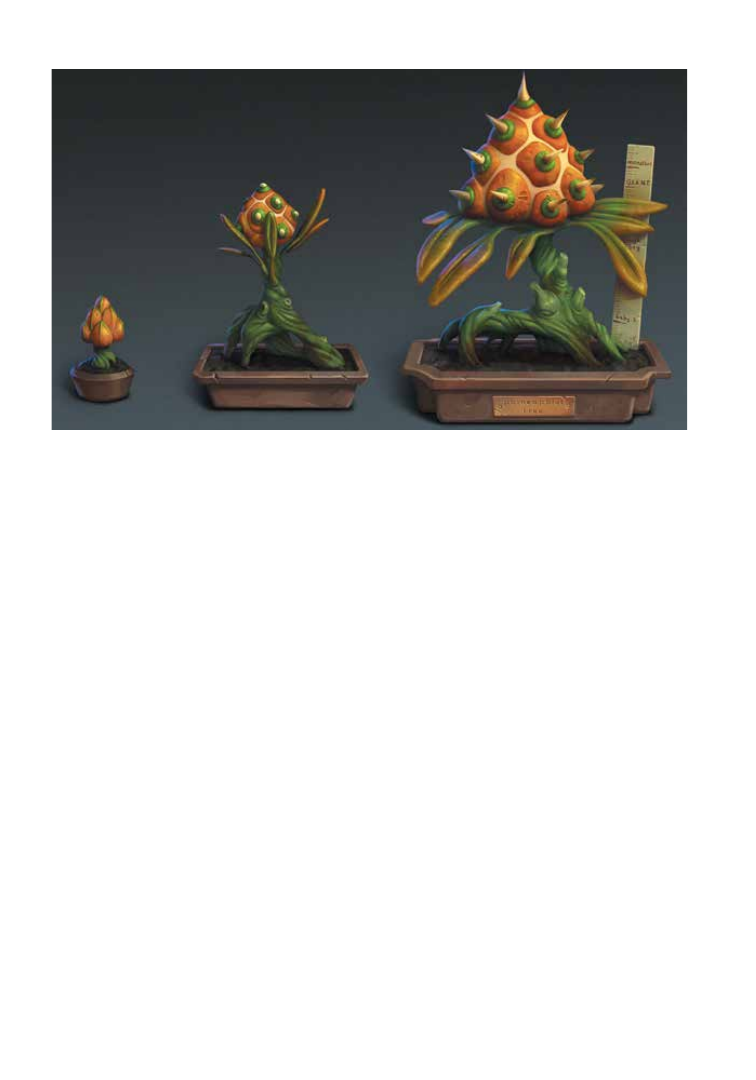
PSB 65 (1) 2019
26
undertones as Emma competes with all those
other water molecules struggling to evaporate
from the interior of the leaf (me first! me first!)
and ultimately gains her freedom through
transpiration.
And here’s the paradox: designing a video
game to be played indoors in order to promote
botany which should take a person outdoors.
One way to bridge that gap is to develop games
which are used exclusively outdoors. For
example, Seek, by iNaturalist, rewards players
with badges for finding examples of plants,
animals, and fungi, using image recognition
technology to identify the player’s uploaded
photographs. For many years, paleontologist
Scott Sampson was the host of Dinosaur Train,
an animated television show teaching children
about prehistoric life and environments
(worth watching even as an adult). He has
always been an advocate for getting out into
nature, yet was part of a show that seemingly
kept kids glued to a screen. In an interview
(Becktold, 2016) about this, Sampson said:
“We’re using technology to leverage nature
connection. If that’s where the eyes are, let’s go
there and promote this thing that’s really good
and important for kids.” I agree.
Video games provide additional ways to
communicate the beautiful science of
plants. The advent of virtual reality (VR)
and augmented reality (AR) will offer
unprecedented opportunity to engage
students and the public in all things botanical.
“The new paradigms of immersion and
interaction provided by these new mediums
creates a new frontier in how we develop and
interact with digital learning content, which is
very exciting,” writes Pittser. And it’s already
happening: Tree, by Milica Zec and Winslow
Porter, is a brilliant new VR project which will
finally give me the chance to see and feel what
it’s like to be a plant. As Stephen Jay Gould
says in his 1993 book, Eight Little Piggies,
“We cannot win this battle to save species and
environments without forging an emotional
bond between ourselves and nature as well—
Figure 4. Fantasy 2D plants created by freelance artist, Olga Samoilova (https://www.artstation.
com/ollsamoilova). The drawing took 64 hours to complete.

PSB 65 (1) 2019
27
for we will not fight to save what we do not
love.” My hope is that the power of video
games will ignite in others the same love of
plants that was ignited in that 10-year-old boy
in his garden so many years ago.
LITERATURE CITED
Becktold, W. 2016. In Conversation with Dinosaur
Train’s Scott Sampson. Sierra, The national maga-
zine of the Sierra Club. https://www.sierraclub.org/
sierra/2016-5-september-october/mixed-media/
conversation-dinosaur-train-s-scott-sampson. Ac-
cessed August 30, 2018.
Blackhall-Miles, R. 2015. We need a cure for plant
blindness. The Guardian. https://www.theguardian.
com/lifeandstyle/gardening-blog/2015/sep/17/we-
need-a-cure-for-plant-blindness. Accessed October
10, 2018.
Cooper, S., Khatib, F., Treuille, A., Barbero, J., Lee,
J., Beenen, M., Leaver-Fay, A., Baker, D., Popović,
Z., and Foldit players. 2010. Predicting protein
structures with a multiplayer online game. Nature
466: 756–760.
Cowley, B., Charles, D., Black, M., and Hickey, R.
2008. Toward an understanding of flow in video
games. Computers in Entertainment 6(2): Article 20.
Csíkszentmihályi, M. 1975. Beyond Boredom and
Anxiety: Experiencing Flow in Work and Play, San
Francisco: Jossey-Bass. ISBN 0-87589-261-2
Dugan, F. M. 2016. Shakespeare, Plant Blindness
and Electronic Media. Plant Science Bulletin 62: 85-92.
ESA, 2018. http://www.theesa.com/about-esa/in-
dustry-facts/. Accessed October 10, 2018.
Higgins, A. 2018. The horticulture industry’s age
problem is bigger than you think. Washington Post.
https://www.washingtonpost.com/lifestyle/home/
the-horticulture-industrys-age-problem-is-bigger-
than-you-think/2018/08/05/3c7d3618-734f-11e8-8
05c-4b67019fcfe4_story.html?noredirect=on&utm_
term=.c6f36926f02a.
Jamonnak, S. and Cheng, E. 2017. Little Botany: A
mobile game utilizing data integration to enhance
plant science education. International Journal of
Computer Games Technology. Article ID 3635061.
https://doi.org/10.1155/2017/3635061
Ke, F. 2009. A qualitative meta-analysis of computer
games as learning tools. In R. E. Ferdig (Ed.), Hand-
book of Research on Effective Electronic Gaming in
Education, pp. 1-32, New York: IGI Global.
Kwok, R. 2017. Game On. Scientists are designing
board, card and digital games to convey scientific
concepts. Nature 547: 369-371.
Limelight Networks, 2018. https://www.limelight.
com/resources/white-paper/state-of-online-gam-
ing-2018/. Accessed October 10, 2018.
McGonigal, J. 2011a. Reality is Broken. Why Games
Make Us Better and How They Can Change the
World. Penguin Books, London.
McGonigal, J. 2011b. FORA.tv. https://www.you-
tube.com/watch?v=IiE2czrG0MI. Accessed August
24, 2018.
Padilla-Zea, N., Gutiérrez, F. L., López-Arcos J. R.,
Abad-Arranz, A., and Paderewski, P. 2014. Mod-
eling storytelling to be used in educational video
games. Computers in Human Behavior 31: 461-474.
Smaldone, R. A., Thompson, C. M., Evans, M.,
and Voit, W. 2017. Teaching science through vid-
eo games. Nature Chemistry 9: 97-102.
Wandersee, J.H. and Schussler, E.E. 2001. Toward
a Theory of Plant Blindness. Plant Science Bul-
letin 47: 2-8.
Wikipedia, 2018.
https://en.wikipedia.org/
wiki/List_of_video_game_genres
. Accessed
August 24, 2018.

PSB 65 (1) 2019
28
PROJECT OBJECTIVES
T
he objectives of this field research
project included: the first comprehensive
survey and inventory of tree canopy biota,
including Myxomycetes, macrofungi, lichens,
mosses, liverworts, ferns, green algae and
cyanobacteria, formerly known as blue
green algae, myxobacteria, insects, and
mollusks in Great Smoky Mountains National
Park (GSMNP); to search for and collect
myxomycete species new to science and
document new records for the park; compare
the assemblages of tree canopy life forms
on the bark of different living tree species
with targeted groups occurring on ground
sites; assemble a diverse team of experts
who will collect, identify, and curate the
targeted organisms; provide mentorship and
publication experiences for undergraduate
and master degree students which will
enhance their opportunities for postgraduate
Student Team-Based Tree
Canopy Biodiversity Research in
Great Smoky Mountains
National Park
study and future careers; involve volunteers,
park interns, teachers, citizen scientists, and
students in interpretative exhibits, news media
coverage (print and television), publication
of articles in popular magazines, newsletters,
and in peer-reviewed journal articles that will
send a powerful message for conservation and
biodiversity; prepare and present posters and
power point talks at local, regional, national,
and international professional meetings
(Keller, 2004).
PROJECT DESIGN PHASES
This research project emphasized three
phases: the Adventure Phase (instruction
and application of rope-climbing techniques
to access and sample from the tree canopy);
the Laboratory Phase (isolation, identification,
database management, and statistical analyses of
tree canopy biota using moist chamber cultures
and other techniques); and the
Publication Phase (students
published in newsletters and
peer-refereed journals and gave
oral and poster presentations
at local, regional, national,
and international professional
meetings (Keller, 2004;
Kilgore et al., 2008)).
By Harold W. Keller, Ph.D.
University of Central Missouri, Biol-
ogy Professor Emeritus and Botanical
Research Institute of Texas, Resident
Research Associate
Botanical Research Institute of Texas
1700 University Drive
Fort Worth, Texas 76107-3400
E-mail: haroldkeller@hotmail.com

PSB 65 (1) 2019
29
STUDENT RECRUITMENT
Informational flyers were posted around
the University of Central Missouri (UCM)
campus and distributed at annual conferences
that described the objectives, the rope-
climbing school, course requirements,
financial support, availability of research
and teaching assistantships, faculty involved
in mentorships, and website access with
scenic photographs of the study area.
Announcements were published in national
newsletters. Presentations were given by
project leaders and students at departmental
seminars, at student orientations, and in
biology courses that highlighted research
results and professional activities.
Interview questions determined student
interest relative to the three project phases and
emphasized experiences beyond just research,
such as travel opportunities, professional
and academic networking, international
collaboration, media and outreach activities,
and grant writing and fundraising experience.
Student selection included review of
transcripts and coursework in biology, a
written essay expressing interest in field
ecology research, letters of recommendation,
and a personal interview. Interviews included
assessment of student ability to follow
instructions and safety protocols, foster
team spirit with a cooperative attitude, and
the interpersonal skills essential for a large
collaborative effort. Prior field experiences
such as hiking, backpacking, and rock or
wall climbing and camping, especially in
remote areas, was an additional consideration
in reviewing applicants. Extracurricular
activities were also important, including
relevant skills obtained in team sports, 4-H
projects, farm or ranching experiences, small
business activities (paper route was one
example), and leadership positions as well
as skills such as use of computer software,
microscopes, digital cameras, topographical
maps, global positioning systems, and future
career interests, especially graduate school
(Keller, 2005).
STUDENT ENROLLMENT IN
COURSES
Each student was required to enroll in BIOL
4011, Special Problems in Biology Research,
for one credit hour. This included preparing
a journal of each day’s field activities and at
the end of the trip a paper organized into
sections (Introduction, Methodology, Results,
Conclusions, and Epilogue) prompted by a
series of leading questions. A few examples of
these questions were: Why was the GSMNP
selected as the study site area? Describe the
advantages and disadvantages of the double
rope-climbing technique? What are some of
the discoveries you made in the tree canopy?
Why did you want to participate in this
research project? What did you learn about
yourself from climbing and sampling from
the tree canopy and living and working with
other student team members? Based on your
observations in the GSMNP, develop a series
of questions or hypotheses used in laboratory
experiments for the targeted organisms.
TEAM SPIRIT, TEAM
BUILDING, AND
ESPRIT DE CORPS
ACTIVITIES
Group activities after a hard day of climbing
and collecting bark samples from trees helped
to break the work routine, and included sorting
bark samples; separating mosses, liverworts,
and lichens; and preparing voucher herbarium
specimens for the tree species. Everyone

PSB 65 (1) 2019
30
pitched in to prepare and cook supper, enjoy a
hot meal together, and wash dishes. Free time,
especially on rainy days, involved the ground
crew, mostly university faculty botanists,
who gave special lectures, slide shows, and
field demonstrations on how to collect and
identify the targeted organisms. This helped
the students learn how to recognize what
they observed in the tree canopy (Keller et al.,
2005).
Field research teams that play together,
stay together—and this helped to develop
a special bond through teamwork. These
group activities involved playing card games;
throwing and catching baseballs, softballs, and
Frisbees; and tossing yard darts. The students
also prepared a group supper for volunteer
park personnel, park interns and rangers, and
friends who assisted us on the trails.
Some students on their days off would hike
and bike into the backcountry to enjoy the
scenic wonders of the Smokies, such as the
flaming azaleas at Gregory Bald and the
Cades Cove loop road, observe spectacular
waterfalls (Abrams Falls, Grotto Falls, and
Laurel Falls), see the synchronous fireflies,
enjoy the thrill of water rafting, or just relax
and read. Kenny Snell collected myxomycetes
at night with a flashlight and discovered tiny
myxomycete fruiting bodies in various stages
of development that glistened and became
more conspicuous at night on the underside
of decaying logs (Keller and Snell, 2018).
These nighttime flashlight forays resulted in
the first-time observations of slugs feeding
on the immature fruiting body stages of
myxomycetes published in the journal
Mycologia, with the digital image of the slug
eating the myxomycete selected for the front
cover artwork (Keller and Snell, 2002).
Melissa Skrabal designed and sketched our
tree canopy biodiversity logo, which was
made into a cloth patch to provide research
team members, volunteers, park personnel
and interns, newspaper reporters, family and
friends with a memento of our tree canopy
biodiversity research project. This logo
recognized the support of the National Science
Foundation and Biodiversity Surveys &
Inventories Program and our home institution
Central Missouri State University (now
UCM). More than 100 of these patches were
distributed and posted on bulletin boards,
worn on blazers and jackets, and identified
gear bags or backpacks (Fig. 1; Kilgore et al.,
2008).
WHY WAS GREAT SMOKY
MOUNTAINS NATIONAL
PARK SELECTED AS A
STUDY AREA?
The park includes more than 210,000 ha and
serves as a refuge for one of the richest and
most diverse biotas in a temperate region of
the world. It contains the largest remaining
Figure 1. Tree canopy biodiversity logo made
into a cloth patch; color sketch by Melissa Sk-
rabal. Photo credit HWK.
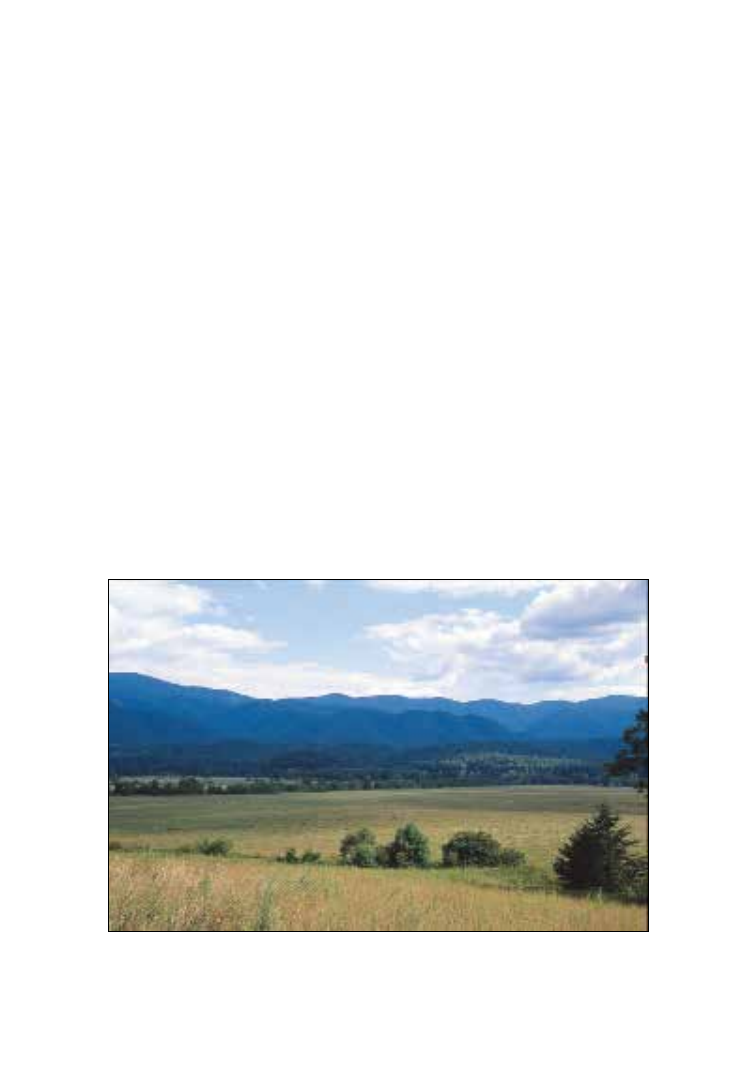
PSB 65 (1) 2019
31
tracts of old-growth forest in the United
States of America estimated at 40,000 ha, and
was designated a National Park on June 15,
1934, an International Biosphere Reserve on
October 26, 1976, and a World Heritage Site
on December 6, 1983. It is home to a variety
of forest types including spruce-fir, northern
hardwood, pine-oak, hemlock, and cove
hardwood with an elevation gradient from
263 to 1994 m. In addition, abundant year-
round rainfall averaging 216 cm annually
with moderate temperatures from 4° to
23°C provides ideal growth conditions for
cryptogams. A new research initiative, the
All Taxa Biodiversity Inventory (ATBI), was
started in 2000 under the rubric of a non-
profit organization, Discover Life in America
(DLIA). It was the first attempt to inventory all
life forms in any American national park (Fig.
2; Keller and Barfield, 2017).
TREE-CLIMBING SCHOOL,
SAFETY PROTOCOLS, AND
LOGISTICAL SUPPORT
A two-day climbing school was held at
Pertle Springs on the UCM campus with a
professional arborist as the instructor. Each
student had to be over the age of 18, have
medical insurance, and was required to sign
a Release and Acknowledgment of Risks
Agreement prior to attending the tree-climbing
school. Contact information was provided in
case of medical emergency as was optional
information regarding any physical condition
that might increase the risk of being in the
field for prolonged times and the endurance
required to hike long distances and to climb
trees. Safety precautions and safe climbing
protocols were emphasized throughout this
tree canopy research project.
Figure 2. Scenic Cades Cove valley where the project lodging was located.
Photo credit HWK.

PSB 65 (1) 2019
32
Park personnel helped in obtaining collecting
permits issued by the U. S. Department of
Interior, provided topographical maps marked
with trails that had champion-sized trees, and
gave briefing sessions on proper conduct in
the park. DLIA provided cabins equipped
with beds, a kitchen, showers, a washer and
dryer, and computer outlets.
PROJECT CHALLENGES
Our greatest challenge was stormy, rainy
weather with lightning strikes, which posed
serious safety hazards. Weather forecasts in
the GSMNP were unreliable since they were
not precise for any specific regions of the park.
Because it is so large, it frequently rains heavily
in one part of the park with little or no rain in
other parts. At lower elevations, movement of
storms was seen at farther distances, and this
allowed the climber ample time to complete
work and exit the tree. Higher altitudes made it
difficult to tell exactly how far away a potential
storm was located because of mountain ridges
blocking long-range views. Furthermore, rain
is also a hazard because wet ropes are more
likely to slip, tightening knots, and making
ascent more difficult. Wet branches reduce
traction, making it more difficult to climb and
move within the tree. Ground sites become
wet and slippery, increasing the chance that
a climber or ground crew member would
fall. Climbing just before, during, and after
thunderstorms was avoided due to safety
concerns (Kilgore et al., 2008).
SPECIAL MEDIA HIGLIGHTS
National Geographic Television produced
two films, “BioBlitz Rock Creek Park 2007”
and “Smoky Mountains Treetop Exploration,”
that appeared as part of the Wild Chronicles
series on Public Broadcasting Stations (PBS)
nationwide. The former was Episode #236,
from August, 2007 and shot in Washington
D.C. at Rock Creek National Park, and the
latter was Episode #318 from February, 2008
and shot in GSMNP (North Carolina and
Tennessee) with running times of seven
minutes for each episode. Boyd Matson
was the host and program narrator. These
films featured UCM women climbers
demonstrating climbing and bark sampling.
In Episode #318, the storyline documented
the exploration of the tree canopy in GSMNP
using the doubled rope climbing method
by student climbers Sydney Everhart and
Courtney Kilgore, who demonstrated how to
access, climb, and gather tree bark samples.
Newspaper reporters interviewed student
climbers and wrote articles about the project;
these were published in the Washington Post,
the Kansas City Star, the Maryville Times, the
Mountain Press, the Tennessean, the Knoxville
News-Sentinel, the Daily-Star Journal,
(Warrensburg, Missouri), UCM Today alumni
magazine, and the Muleskinner (UCM student
newspaper). Some of these articles appeared
on the front page under banner headlines and
went out on the Associated Press Wire Service.
OUTREACH ACTIVITIES
AND
STUDENT MENTORING
OPPORTUNITIES
The NSF Research Experience for Teachers
Program grant financially supported Trish
Smith, a Warrensburg Middle School 7th-
grade life science teacher, and her students in
a tree canopy study at Pertle Springs on the
UCM campus. This research project involved
UCM faculty and students who mentored
the students in field collection of tree bark
samples and monitored the preparation and
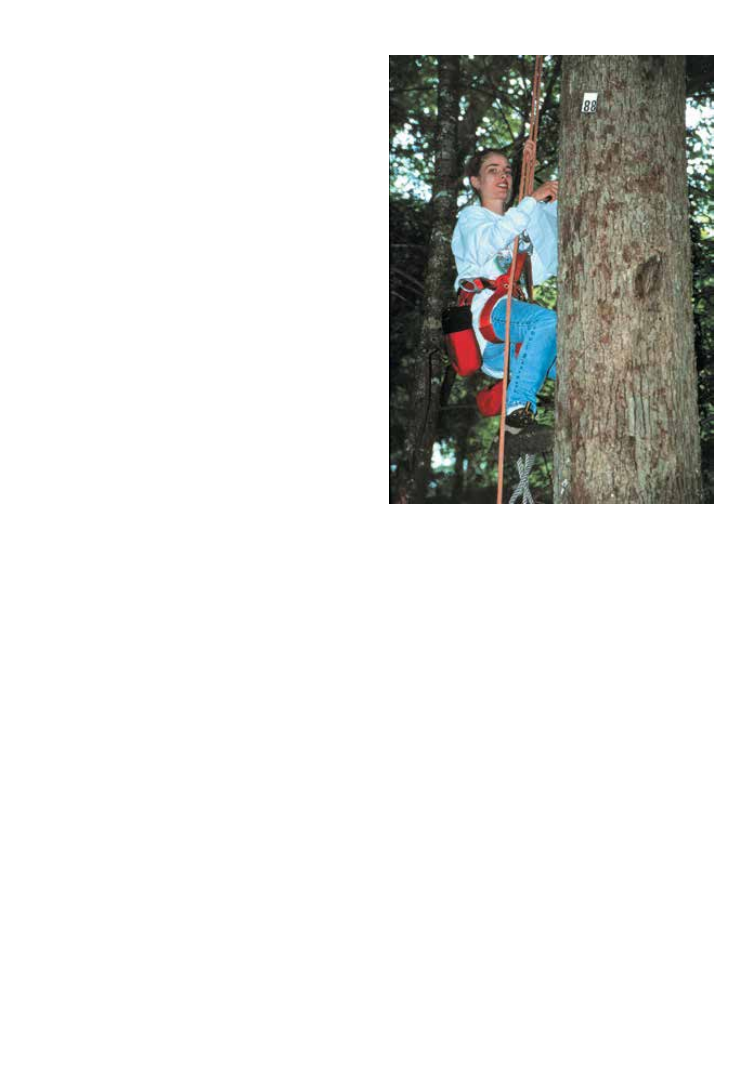
PSB 65 (1) 2019
33
observation of moist chamber bark cultures
in the laboratory. This provided mentorship
opportunities for female UCM students who
helped students detect and identify many
different life forms in moist chamber cultures
(Smith and Keller, 2004).
STUDENT ACHIEVEMENTS
Kenny Snell conducted the first tree canopy
study during the summers of 2000 and
2001 to characterize myxomycete (slime
mold) communities using the doubled
rope-climbing method in GSMNP. Most
myxomycete species had an optimum pH
and were obtained from all heights from 3 to
24 m based on bark samples collected from
living trees cultured in moist chambers. The
standard practice of collecting bark samples
from living trees at about 3 m will recover the
majority of myxomycete species cultured in
moist chambers. Thirty myxomycete species
new to the park were recorded from the tree
canopy (Snell and Keller, 2003; Snell et al.,
2003; Keller, 2004). A departmental, college,
and university review panel recognized Kenny
Snell with the two highest awards a graduate
student can receive at UCM: first place for the
Graduate Student Thesis Award and first place
for Outstanding Graduate Scholar Award.
He currently is an instructor at Metropolitan
Community College, Kansas City Missouri
and teaches botany, environmental science,
and genetics.
Melissa Skrabal discovered a new myxomycete
species, Diachea arboricola, on July 4, 2000
high in the tree canopy of a living White
Oak tree in the Cades Cove area of GSMNP
(Fig. 3). Plasmodial tracks (veins of the slime
plasmodial stage) were found on the bark
surface along with mature stalked sporangia in
perfect condition, extending from 10 to 24 m.
This observation of plasmodial tracks up to 24
m with scattered sporangia forming along the
way had never been described and published.
Tiny stalked sporangia (1–1.3 mm in total
height) were collected from the crevices and
fissures of the bark exposing their glittering,
iridescent, silvery-golden outer surface and
basal spectral rainbow colors of the spore-
containing spheres (Fig. 4). She observed
the bright yellow phaneroplasmodial stage
with a network of trailing plasmodial veins
and described subsequent development of
sporangial formation from bark culture in
moist chambers (Keller et al., 2004; Keller,
2005; Keller et al., 2009). She graduated in
2001 from Central Missouri State University,
Magna Cum Laude.
Figure 3. Melissa Skrabal with climbing gear
collecting bark samples from the canopy of a
live white oak tree #88. Photo credit HWK.

PSB 65 (1) 2019
34
Sydney Everhart found that there was
no association between percent cover of
epiphytes and myxomycetes; however, she
did demonstrate that bark pH was a major
factor influencing a community of corticolous
myxomycete species. Acidic tree bark had a
specific group of myxomycete species that was
different from species associated with near
neutral tree bark. She concluded that some
myxomycetes are restricted to bark with a
narrow pH range whereas others are generalists
occurring on a wide range of pH. Patchy
distribution of myxomycetes was attributed
to the small plasmodium characteristic of
most corticolous species (Everhart et al.,
2009; Everhart et al., 2008; Everhart and
Keller, 2008). She received multiple awards
for her tree canopy research including the
Association of Southeastern Biologists (ASB)
Research Award in Microbiology for the
outstanding oral presentation and the Elsie
Quarterman-Catherine Keever Award for the
best ecological poster at the 2007 ASB annual
meeting, UCM Research Council’s first place
award for Outstanding Graduate Thesis, and
Biology Department Outstanding Graduate
Student Award. She earned her Ph.D. from
the University of Georgia and is currently
Assistant Professor/Quantitative Ecologist
in the Department of Plant Pathology at the
University of Nebraska-Lincoln.
Courtney Kilgore’s research on myxomycete
aerial reproductive structures is a canopy-first
study of this type. Myxomycete communities
were different on bark and pine cones of short-
leaf pine as were communities on redbud bark
and aerial seed pods, and common milkweed
stems and follicles, coneflower stems and
inflorescences, and Yucca stems and follicles.
Colonization patterns for the herbaceous
perennial prairie plants occurred within a
year and were distinct enough to warrant the
coinage of a new habitat term, herbicolous,
for these myxomycetes (Kilgore et al., 2009).
Her climbing knowledge, application of
safety protocols, and athletic skills using
the double rope-climbing method were
highlighted in JBRIT (Kilgore et al., 2008,
2009). She received the UCM Nahm Award
for the Outstanding Graduate Student from
the UCM College of Science and Technology.
A photograph of her collecting bark samples
in the tree canopy was on the front cover of
the July 2008 issue of Southeastern Biology
journal. The Mycological Society of America
(MSA) held their annual meeting (2008) at
Pennsylvania State University, and each year
there is a t-shirt design contest open to all
MSA members. Courtney submitted a black-
and-white pencil sketch that was selected as
the contest winner. Four edible mushroom
cultivars were included in the winning design:
Shiitake, Hen of the Woods, Portabella white
variety, and the velvet foot mushroom with
four mold species adorning the outer edge
Figure 4. Stalked iridescent sporangium of a
new species of myxomycete Diachea arbori-
cola. Photo credit KLS.

PSB 65 (1) 2019
35
(Fig. 5). She currently is an instructor of
botany and biology at Robeson Community
College, Lumberton, North Carolina.
Erica Parker studied the relationship between
pH and myxomycete communities on bark of
five living tree species at Big Oak Tree State
Park, Missouri. She found that American
elms with a neutral pH of 7.0 had a distinct
group of corticolous myxomycete species
and bald cypress with a more acidic pH of
4.6 had a different group. She represented
the Department of Biology and her McNair
Scholar’s paper received the first-place award.
She graduated Cum Laude in 2004 from UCM
(Parker and Keller, 2003).
Angela Scarborough collected bark samples
from the tree canopy at high elevation sites
(about 1800 m) in the Clingmans Dome area
of GSMNP from Fraser fir and red spruce,
both with a pH near 4.0. These species are
gradually declining and dying apparently due
to acid deposition and aerial pollution. Fraser
fir harbored no myxomycete species, whereas
red spruce had the lowest mean bark pH and a
distinctive assemblage of myxomycete species.
Eastern red cedar, sampled at low elevation
sites in GSMNP and Warrensburg, had a pH
near neutral, with the highest myxomycete
diversity of any tree species studied (Keller
et al., 2009; Scarborough et al., 2009).
Competing against graduate students at the
ASB 2006 annual meeting held in Gatlinburg,
Tennessee, she won first place for the
outstanding microbiology oral presentation
and first place for the best ecology poster, the
Elsie Quarterman-Catherine Keever award.
She also received the UCM Sigma Xi best
undergraduate student paper award, the UCM
Department of Biology and Earth Science
Undergraduate Research award, as well as
the UCM Distinguished Student Writer
based on her tree canopy biodiversity paper
(Scarborough et al., 2009).
CONCLUSIONS
This tree canopy research project (years 2000–
2008) resulted in 28 peer reviewed papers,
12 newsletter articles, 28 oral presentations,
and 30 poster presentations at professional
meetings, including the International
Congress on the Systematics and Ecology of
Myxomycetes, Association of Southeastern
Biologists, Mycological Society of America,
and Missouri Academy of Sciences. More
information is available at http://www.brit.
org/HKeller, and PDFs are available from the
author. Traditionally males have dominated
field research in ecology, but in this tree
canopy study, females dominated.
Figure 5. Illustrated fungi, mushrooms, and
molds t-shirt design.

PSB 65 (1) 2019
36
ACKNOWLEDGMENTS
This tree canopy study would not have been
possible without the financial support of
the National Science Foundation, National
Geographic Society Research Committee,
Discover Life in America, Missouri Department
of Natural Resources, Sigma Xi, The Scientific
Research Honor Society, and United States
Department of Education McNair Scholars
Program. Thanks go to many others who helped
us in countless ways.
This research project was a team effort involving
undergraduate and master’s degree students and
faculty research mentors from the University of
Central Missouri (UCM) and other universities.
Student participants who published papers in
peer-reviewed journals were: Sydney E. Everhart,
M.S., Courtney M. Kilgore, M.S., Kenneth W.
Snell, M.S., Erin E. Fanning, B.S., Erica E. Parker,
B.S., Angela R. Scarborough, B.S., Melissa S.
Skrabal, B.S. (arranged alphabetically with
graduation degrees).
LITERATURE CITED
Everhart, S. E., J. S. Ely, and H. W. Keller. 2009.
Evaluation of tree canopy epiphytes and bark
characteristics associated with the presence of
corticolous myxomycetes. Botany 87: 509–517.
Everhart, S. E., and H. W. Keller. 2008. Life his-
tory strategies of corticolous myxomycetes: the
life cycle, fruiting bodies, plasmodial types, and
taxonomic orders. International Journal of Fun-
gal Diversity 29: 1–16.
Everhart, S. E., H. W. Keller, and J. S. Ely. 2008.
Influence of bark pH on the occurrence and distri-
bution of tree canopy myxomycete species. Myco-
logia 100: 191–204.
Keller, H. W. 2004. Tree canopy biodiversity: stu-
dent research experiences in Great Smoky Moun-
tains National Park. Systematics and Geography
of Plants 74: 47–65.
Keller, H. W. 2005. Undergraduate research field
experiences: tree canopy biodiversity in Great
Smoky Mountains National Park and Pertle
Springs, Warrensburg, Missouri. (Invited Paper).
Council on Undergraduate Research Quarterly
25: 162–168.
Keller, H. W., and K. M. Barfield. 2017. Great
Smoky Mountains National Park: The people’s
park. Fungi 10: 44–64.
Keller, H. W., S. E. Everhart, M. Skrabal, and C.
M. Kilgore. 2009. Tree canopy biodiversity in
temperate forests: exploring islands in the sky.
(Special invited paper.) Southeastern Biology 56:
52–74.
Keller, H. W., M. Skrabal, U. H. Eliasson, and
T. W. Gaither. 2004. Tree canopy biodiversity in
the Great Smoky Mountains National Park: eco-
logical and developmental observations of a new
myxomycete species of Diachea. Mycologia 96:
537–547.
Keller, H. W., and K. L. Snell. 2002. Feeding ac-
tivities of slugs on Myxomycetes and macrofungi.
Mycologia 94: 757–760. [Color image of a slug
feeding on immature myxomycete sporangia se-
lected for the front cover artwork.]
Keller, H. W., and K. L. Snell. 2018. Hunting and
collecting myxomycetes at night with a flashlight.
Fungi 11: 43–44.
Kilgore, C. M., H. W. Keller, and J. S. Ely. 2009.
Aerial reproductive structures on vascular plants
as a microhabitat for myxomycetes. Mycologia
101: 303–317.
Kilgore, C. M., H. W. Keller, S. E. Everhart, A. R.
Scarborough, K. L. Snell, M. S. Skrabal, C. Pot-
torff, J. S. Ely. 2008. Research and student expe-
riences using the doubled rope climbing method.
Journal of the Botanical Research Institute of
Texas 2: 1309–1336.

PSB 65 (1) 2019
37
Parker, E. E., and H. W. Keller. 2003. Correlation
of pH with assemblages of corticolous myxomy-
cetes in Big Oak Tree State Park. Journal of the
McNair Central Achievers Program, University of
Central Missouri. Vol. XII (Issue 1): 4–8. [Award-
ed first place by a university panel of judges.]
Scarborough, A. R., H. W. Keller, and J. S. Ely.
2009. Species assemblages of tree canopy myxo-
mycetes related to pH. Castanea 74: 93–104.
Smith, P. A., and H. W. Keller. 2004. National Sci-
ence Foundation Research Experience for Teach-
ers (RET). Inoculum 55: 1–5.
Snell, K. L., and H. W. Keller. 2003. Vertical dis-
tribution and assemblages of corticolous myxo-
mycetes on five tree species in the Great Smoky
Mountains National Park. Mycologia 95: 565–
576.
Snell K. L., H. W. Keller, and U. H. Eliasson.
2003. Tree canopy myxomycetes and new records
from ground sites in the Great Smoky Mountains
National Park. Castanea 68: 97–108.
ADDITIONAL RELATED
PUBLICATIONS NOT CITED
Keller, H. W., S. E. Everhart, and C. M. Kilgore.
2017. The Myxomycetes: Basic Biology, Life Cy-
cles, Genetics and Reproduction. In: Stephenson,
S. and C. Rojas (eds). Myxomycetes: Biology,
Systematics, Biogeography and Ecology, Chapter
1, pp. 1–40. Elsevier, Atlanta, GA.
Keller, H. W., P. Davison, C. Haufler, and D. B.
Lesmeister. 2003. Polypodium appalachianum:
an unusual tree canopy epiphytic fern in the Great
Smoky Mountains National Park. American Fern
Journal 93: 36–41.
Keller, H. W., and C. M. Kilgore. 2008. Smoky
mountains treetop exploration airs on Wild Chron-
icles. Inoculum 59(2): 47.
Keller, H. W., and M. Skrabal. 2002. Discovery
of a new obligate tree canopy myxomycete in the
Great Smoky Mountains National Park. Inoculum
53: 1–4.
Skrabal, M., K. L. Snell, L. Henley, J. Counts, and
H. W. Keller. 2001. Fungi in the canopy - Great
Smokies survey. The Mycophile, Newsletter for
the North American Mycological Association 42:
6, 7, 13.

38
SCIENCE EDUCATION
By Dr. Catrina Adams,
Education Director
BSA Science Education News and Notes serves
as an update about the BSA’s education efforts
and the broader education scene. We invite
you to submit news items or ideas for future
features. Contact Catrina Adams, Education
Director, at cadams@botany.org.
As we get midway through the latest
PlantingScience session, we have just under
236 student teams actively investigating seeds
germination, photosynthesis, and agronomy.
We love to brag about our scientist mentors on
Facebook, but they really have been doing an
amazing job this session. From encouraging
students to consider why their predictions are
what they are to providing extra resources,
PlantingScience mentors have been hard at
work training the next generation of plant
scientists!
Great hypothesis - I especially like that you
have a good reason for saying your hypothesis,
which is important! Hypotheses shouldn’t just
be guesses, but based on what’s already known.
And you used what you know about acid rain to
make your hypothesis! (Nicole Soper Gorden,
mentor extraordinaire)
PlantingScience’s
Spring Session is Underway!
Our liaisons have been phenomenal as well
keeping their teacher partners updated and
helping them get their groups up and running.
We have a few teachers who are new to the
platform, so our liaisons have been doing an
excellent job of keeping teachers, mentors,
and students updated and on the same page.
One thing that is clear this session is that
liaisons and teachers now recognize mentors
and are selecting the same mentors from
previous session. Mentors and teachers alike
are pleased!
My name is Liming and I am the liaison for
this project. As the start date is approaching, I
wonder if there’s anything I can help with, for
example creating project teams? Otherwise
if you can give me some information on the
potential number of mentors needed, I can
start to send out invitations. Look forward to
this new semester! (Liming Cai, First-time
PlantingScience Liaison)
All of the teachers who have participated
previously on the current PlantingScience
platform are enthusiastic and excited to be
participating again. Many have posted in
their forums something along the lines of
“PlantingScience is one of the favorite projects
for my students.” We hope that the session
continues to run smoothly for our teachers,
students, mentors, and liaisons.
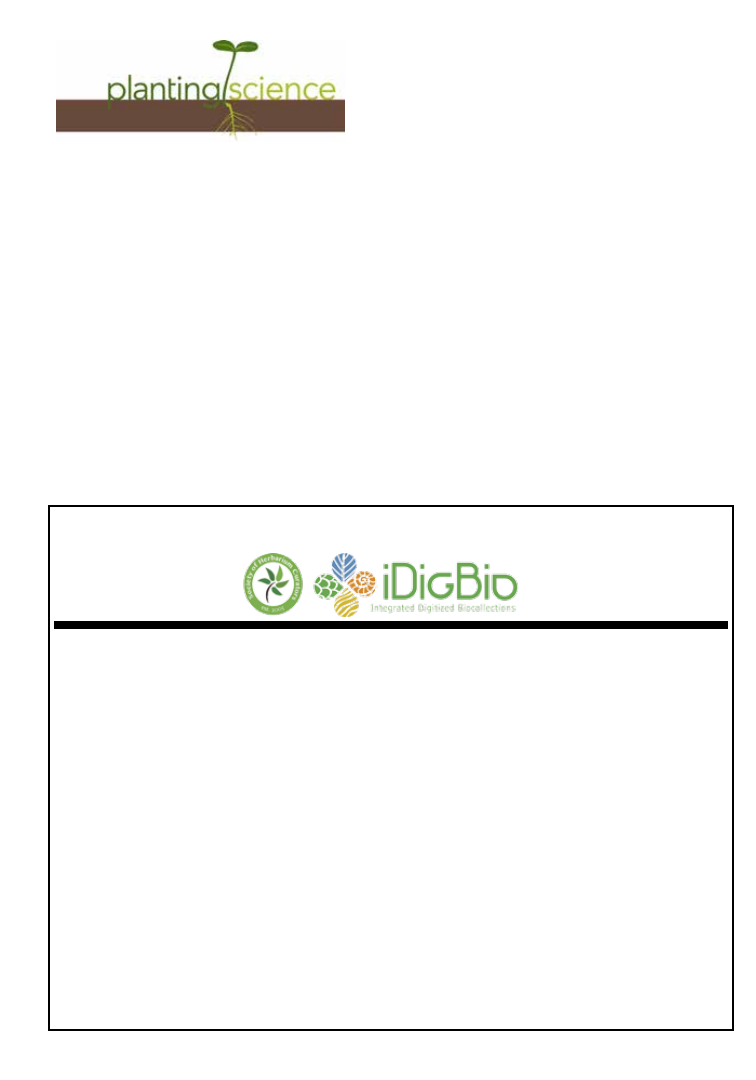
39
I am Sharon Harris, the Botany teacher of 7
junior and senior young women who are curious
about the world around them and anxious to
start this project. Two of the students worked
on The Power of Sunlight module last year with
me in AP Biology and when I told them we were
doing this, they couldn’t stop telling the other 5
what a cool thing this was going to be. (Sharon
Harris, PlantingScience Teacher)
Seeds and plants are not my expertise - so I’m so
happy to be working with you all! (now when we
do our Plate Tectonics Unit, then I’m in my real
wheelhouse!) Last year my students did some
great projects and I can’t wait to get started this
year. (Sara Melman, PlantingScience Teacher)
I am so excited to start this project with you
all! Thank you for dedicating your time to
mentor my students. (Phalguni Desai, NEW
PlantingScience Teacher)
Finally, we are excited to be running a beta
test of a new the plant pathology module, on
which we worked with our APS partner to
create a new module based on the paper from
Hirsch et al. (2018) in The American Biology
Teacher.
LITERATURE CITED
Hirsch, R. Louis, Miller, Seth, and Halterman,
Dennis. “An Inquiry-Based Investigation of Bac-
terial Soft Rot of Potato.” The American Biology
Teacher, Vol. 80, No. 8, pp. 594–599, ISSN 0002-
7685, electronic ISSN 1938-4211. DOI: https://
doi.org/10.1525/abt.2018.80.8.594.
Early-Career Innovators in Herbarium-Enabled Research and
Future-Proofing for the Next Waves of Inventiveness
Thursday, August 1, 2019
7:30 am - 1:00 pm
Starr Pass, Tucson
This Society of Herbarium Curators-organized event at www.botanyconference.org,
co-sponsored by iDigBio, will provide a venue for eight current and recent NSF Postdoctoral Fellows
to present their herbarium-enabled research and provide fresh opinions on how collections can
position themselves and the specimens and data that they curate to produce maximum research
relevance in the next waves of innovation. These eight participants will present on a range of
collections-enabled research topics, including such topics as Plant Invasions, Plant Responses to
Extreme Events, Sand-Entrapment by Plants, Plant Extinctions on Islands, Evolution of Floral
Scent, Herbarium Genomics, Parasitic Plants, and Tropical Tree Diversity. The 25-minute
research talks will be interspersed with whole-group discussions of ideas raised by the speakers.
Organized by: Austin Mast, Department of Biological Science, Florida State University
and Patrick Sweeny, Peabody Museum of Natural History, Yale University
Sign up for this symposia when you register for Botany 2019 at www.botanyconference.org
Cost: $45.00 includes Lunch and Snacks
A Special Post–Botany 2019 Symposium
Sponsored by:

40
STUDENT SECTION
By Chelsea Pretz and Min Ya
BSA Student Representatives
It’s that time of the semester where you start to compile every opportunity you want to apply
to into one list. To make this easier for you, we have compiled a list of all the opportunities we
know about.
On the following pages, we have four categories for easy browsing that include the following:
Grants and Awards, Broader Impacts, Short Courses and Workshops, and Job Hunting.
GRANTS AND AWARDS
Grants and awards can help fund your research, provide assistance for travel related to training,
fieldwork, or conferences, and even contribute to your cost-of-living and tuition expenses (e.g.,
fellowships). Additionally, applying for grants and awards is a great opportunity to hash out a
research plan as well as fine tune your writing skills by articulating said research plan. Lastly,
don’t forget to check with your department and university to become familiar with internal
grants that you can apply for!
Grants and Awards Offered by BSA
Supporting student research is one of the most important missions of our Botanical Society of
America, and starting from this year, BSA increased the Graduate Student Research Awards
from $500 to $1500! This increase will make many impossible possible, and there are 20 total
awards in 2019. Make sure to check out the “Awards” section on botany.org and pay
attention to the deadlines.
Roundup of Student Opportunities

PSB 65 (1) 2019
41
BSA Graduate Student Research Awards
Including the J. S. Karling Award
Amount: $1500
Deadline: Mar. 15
Purpose: Research funds
More info: https://botany.org/home/awards/awards-for-students/
BSA Undergraduate Student Research Awards
Amount: $200
Deadline: Mid-Mar.
Purpose: Research funds
More info: https://botany.org/home/awards/awards-for-students/
BSA Graduate Student Research Awards Given by Sections
Amount: $500
Deadline: Mid-Mar.
Purpose: Research funds
More info: https://botany.org/home/awards/awards-for-students/
You can also research out to your section leaders to ask about awards they are offering this year!
BSA Student Travel Awards
Including TRIARCH “Botanical Images” Student Travel Award and Awards Given by Sections
Amount: Variable
Deadline: Mar-Apr
Purpose: Travel to the
conference
More info: https://botany.org/home/awards/travel-awards-for-students/
You can also research out to your section leaders to ask about awards they are offering this year!
Botany 2019 Travel Grants for Presenters from Developing Nations
Amount: $1000
Deadline: Mar. 15
Purpose: Travel to the
conference
More info: https://botany.org/home/awards/developing-nations-travel-grants.html
PLANTS Grants
Amount: Variable
Deadline: Mar. 1
Purpose: Cover costs of travel, registration, food, and accommodation at the conference
More info: https://botany.org/home/awards/travel-awards-for-students/plants-grants.html

PSB 65 (1) 2019
42
National Science Foundation Graduate Research Fellowship Program (NSF GRFP)
Amount: $34k per year + tuition aid
Deadline: Oct.
Nationality/Affiliation requirement: Must be a U.S. citizen, national, or permanent resident
Purpose: Support outstanding graduate students in NSF-supported disciplines who are
pursuing research-based Master's and doctoral degrees at accredited U.S. institutions.
More info: https://www.nsfgrfp.org/
Fulbright U.S. Student Program
Amount: Variable
Deadline: Oct.
Nationality/Affiliation requirement: Must be citizens or nationals of the U.S. at the time of
application; permanent residents are not eligible.
Purpose: Covers transportation and living expenses in host country. Tuition & school-related
fees covered in some countries
More info: http://us.fulbrightonline.org/about/types-of-awards/study-research
American Association of University Women (AAUW) Dissertation Fellowship
Amount: $20,000
Deadline: Nov. 1
Nationality/Affiliation requirement: Must be a female U.S. citizen, national, or permanent
resident
Purpose: Dissertation Fellowships offset a scholar’s living expenses while she completes
her dissertation. The fellowship must be used for the final year of writing the dissertation.
Applicants must have completed all course work, passed all preliminary examinations, and
received approval for their research proposals or plans by the preceding November.
More info: https://www.aauw.org/what-we-do/educational-funding-and-awards/american-
fellowships/
NIH Postbac Intramural Research Training Award (POSTBAC IRTA/CRTA)
Amount: One year stipend ~$34k
Deadline: 6 months before intended start date
Nationality/Affiliation requirement: Must be an U.S. citizen, national, or permanent resident
Purpose: Recent college graduates who are planning to apply to graduate or professional
(medical/dental/pharmacy/nursing/veterinary, etc.) school an opportunity to spend one or
two years performing full-time research at the NIH.
More info: https://www.training.nih.gov/programs/postbac_irta
GRANTS AND AWARDS OFFERED BY
OTHER ORGANIZATIONS

PSB 65 (1) 2019
43
CIC Smithsonian Institution Fellowship
Amount: $36k for one year
Deadline: Nov.
Nationality/Affiliation requirement: Only students currently enrolled in one of the Big Ten
Academic Alliance member universities are eligible.
Purpose: To support research in residence at Smithsonian Institution facilities. All fields of
study that are actively pursued by the museums and research organizations of the Smithsonian
Institution are eligible.
More info: http://www.btaa.org/resources-for/students/smithsonian-fellowship
Ford Foundation Fellowship Programs
Amount: $24K-$45K, for 1-3 years
Deadline: Dec.
Nationality/Affiliation requirement: All U.S. citizens, U.S. nationals, and U.S. permanent
residents (holders of a Permanent Resident Card), as well as individuals granted deferred
action status under the DACA Program
Purpose: Three fellowship types are offered: Predoctoral, Dissertation, and Postdoctoral. The
Ford Foundation seeks to increase the diversity of the nation’s college and university faculties.
More info: http://sites.nationalacademies.org/pga/fordfellowships/index.htm
SMART Program
Amount: $25K-$38K/year + tuition
Deadline: Dec.
Nationality/Affiliation requirement: Must be an U.S. citizen, national, or permanent resident
Purpose: To increase the number of scientists and engineers in the DoD. The program is
particularly interested in supporting individuals that demonstrate an aptitude and interest in
conducting theoretical and applied research.
More info: http://smartscholarship.org/
Torrey Botanical Society Fellowships and Awards
Amount: Up to $2500
Deadline: Jan. 15
Nationality/Affiliation requirement: Must be a member of the society
Purpose: To support research/education of student members by funding field work,
recognizing research in conservation of local flora/ecosystems, or funding course
attendance at a biological field station.
More info: http://www.torreybotanical.org/grants-awards/

PSB 65 (1) 2019
44
Botany In Action Fellowship
Amount: Up to $5000
Deadline: Dec. 20
Nationality/Affiliation requirement: Enrolled in a Ph.D. program at a U.S. graduate
institution (U.S. citizenship is not required)
Purpose: To develop new, science-based plant knowledge and chronicles traditional
knowledge of plants. BIA promotes interactive scientific education about the importance of
plants, biodiversity, and sustainable landscapes.
More info: https://www.phipps.conservatory.org/green-innovation/for-the-world/botany-
in-action/call-for-proposals
The Lewis and Clark Fund for Field Research
Amount: Up to $5000
Deadline: Nov.
Nationality/Affiliation requirement: open to U.S. citizens and residents wishing to carry out
research anywhere in the world. Foreign applicants must either be based at a U.S. institution
or plan to carry out their work in the U.S.
Purpose: To encourage exploratory field studies for the collection of specimens and data as
well as provide the imaginative stimulus that accompanies direct observation.
More info: https://www.amphilsoc.org/grants/lewis-and-clark-fund-exploration-and-field-
research
ASPT Graduate Student Research Grants
Amount: Up to $1000
Deadline: Feb. 28
Nationality/Affiliation requirement: Must be a member of the society
Purpose: To support both master’s and doctoral students conducting field work, herbarium
travel, and/or laboratory research in any area of plant systematics.
More info: www.aspt.net/award
Richard Evans Schultes Research Award
Amount: Up to $2500
Deadline: Mar 30
Nationality/Affiliation requirement: Must be a member of the society
Purpose: To help defray the costs of field work on a topic related to economic botany for
students who are members of the Society for Economic Botany.
More info: http://www.econbot.org/index php?module=content&type=user&func=view&pid=50
Sigma Xi Grants-in-Aid of Research
Amount: Up to $1000
Deadline: Mar 15; Oct. 1
Nationality/Affiliation requirement: Preference will be given to members of the society
Purpose: To encourage close working relationships between students and mentors, this
program promotes scientific excellence and achievement through hands-on learning.
More info: www.sigmaxi.org/programs/grants-in-aid

The Exploration Fund Grant
Amount: Up to $2500
Deadline: mid-Nov.
Nationality/Affiliation requirement: Grant does not apply to Chinese citizens
Purpose: To encourage research focused on systematics; also, projects of a more general or
educational nature will also be considered, provided that they include a strong systematics
component.
More info: https://systass.org/grants-and-awards/srf/
Garden Club of America Scholarships
Amount: $2500-$8000
Deadline: Feb. 1
Nationality/Affiliation requirement: U.S. Citizens and permanent residents who are enrolled
in a U.S.-based institution.
Purpose: To encourage research focused on systematics; also, projects of a more general or
educational nature will also be considered, provided that they include a strong systematics
component.
More info: www.gcamerica.org/scholarships
P.E.O. Scholar Award
Amount: Up to $15,000
Deadline: Dec.
Nationality/Affiliation requirement: Must be a citizen or legal permanent resident of the U.S.
or Canada
Purpose: To encourage research focused on systematics; also, projects of a more general or
educational nature will also be considered, provided that they include a strong systematics
component.
More info: https://www.peointernational.org/psa-eligibility-requirements
Grants from the Wetland Foundation
Amount: Up to $1600
Deadline: Dec. 18
Nationality/Affiliation requirement: Any student currently enrolled full-time at an academic
institution in the U.S.
Purpose: To support wetland education and research
More info: http://thewetlandfoundation.org/The_Wetland_Foundation/Wetland_Grants.html
National Geographic Young Explorers Grants
Amount: Up to $5000
Deadline: 10 months before proposed work
Nationality/Affiliation requirement: None
Purpose: Support research, conservation, and exploration-related projects consistent with
National Geographic's existing grant programs. In addition, this program provides increased
funding opportunities for field work in 18 Northeast and Southeast Asian countries.
More info: https://www.nationalgeographic.org/grants/grant-opportunities/

The Mohamed Bin Zayed Species Conservation Fund
Amount: Up to $25,000
Deadline: Feb.; June; Oct.
Nationality/Affiliation requirement: None
Purpose: To support from conservationists based in all parts of the world dealing with plant
and animal species.
More info: https://www.speciesconservation.org/grants/
Research Fellowships/Awards from the Arnold Arboretum
Amount: Up to $10,000
Deadline: Feb. 1
Nationality/Affiliation requirement: None
Purpose: Multiple awards and/or fellowships are offered for undergraduate and graduate
students with topics that focus on Asian tropical forest biology and comparative biology of
woody plants.
More info: www.arboretum.harvard.edu/research/fellowships/
The Councils of the Linnean Society and the Systematics Association:
Systematics Research Fund
Amount: $1000-$1500
Deadline: Feb. 20
Nationality/Affiliation requirement: None
Purpose: To encourage research focused on systematics; also, projects of a more general or
educational nature will also be considered, provided that they include a strong systematics
component.
More info: https://systass.org/grants-and-awards/srf/
Awards from New England Botanical Club
Amount: $1000-$2000
Deadline: Mar 1
Nationality/Affiliation requirement: None
Purpose: To encourage botanical research in New England region.
More info: http://www.rhodora.org/
SSB Mini-Arts Grant
Amount: Up to $4000
Deadline: Nov. 15
Nationality/Affiliation requirement: None
Purpose: This is to fund young researchers to spend a summer or semester apprenticed to an
expert in a particular taxonomic group or to enhance revisionary taxonomic and systematics
research in novel ways.
More info: https://www.systbio.org/mini-arts-awards.html

SSB Graduate Student Research Awards
Amount: $1000-$2000
Deadline: Fall
Nationality/Affiliation requirement: None
Purpose: Eligibility of this award to master’s students in the first 2 years of their studies and
PhD students in the first 4 years for students to work on systematic questions below and
above the species level, molecular and morphological approaches, and issues of pattern and
process.
More info: https://www.systbio.org/graduate-student-research-awards.html
Evolutionary, Ecological, or Conservation Genomics (EECG) Research Award
Amount: $5000-$10,000
Deadline: Feb. 1
Nationality/Affiliation requirement: None
Purpose: Priority for funding will be given to proposals that address genome-scale
questions, or ecological, evolutionary, and conservation genetics questions that are best
addressed using genomic approaches in a hypothesis-testing framework.
Society for the Study of Evolution Grants
Amount: $2000-$3500
Deadline: Varies
Nationality/Affiliation requirement: None
Purpose: This society has a range of grants that service students pursuing evolutionary research.
More info: http://www.evolutionsociety.org/content/society-awards-and-prizes/graduate-
research-excellence-grants.html
Prairie Biotic Research Small Grants
Amount: $1500
Deadline: Varies
Nationality/Affiliation requirement: None
Purpose: Supports the study of any species in U.S. prairies and savannas.
More info: https://prairiebioticresearch.org
The Mohamed Bin Zayed Species Conservation Fund
Amount: up to $25,000
Deadline: Varies
Nationality/Affiliation requirement: None
Purpose: The Mohamed Bin Zayed Species Conservation Fund is a new and significant
philanthropic endowment established to directly support the cause of species conservation.
It is open to applications for funding support from conservationists based in all parts of the
world dealing with plant and animal species.
More info: https://www.speciesconservation.org/grants/

BROADER IMPACT OPPORTUNITIES
These are not just for NSF grants! Sharing your passion for plants and science with a wide
range of audiences will help develop speaking skills as well as help you reconnect with why
you decided to go to grad school after all.
PlantingScience
What it is:
A learning community where scientists provide online mentorship
to student teams as they design and think through their own inquiry
projects.
What you can do:
Interact with grade school-to-college students online, as they work on
plant-focused learning modules in the classroom.
More info:
www.plantingscience.org/
Science Olympiad
What it is:
Competitions are like academic track meets, consisting of a series of
23 team events in each division (middle school or high school). Each
year, a portion of the events are rotated to reflect the ever-changing
nature of genetics, earth science, chemistry, anatomy, physics, geology,
mechanical engineering, and technology.
What you can do:
Mentor local students in person on a variety of science- and engineering-
oriented topics and skills; help organize and run competitions
More info:
www.soinc.org/
Local Arboretums, Parks, Museums, and Herbaria
What it is:
These institutions often depend on volunteers to donate their time and
expertise to help people of all ages enjoy their collections and grounds.
They may already have programs in place that allow you to lead tours
or interact with visitors at special events so that you can share your
interests and passion.
What you can do: Lead tours; help organize and run events
More info:
Look up local parks/arboretums/museums/herbaria online, or inquire
at visitors’ centers.

SHORT COURSES AND WORKSHOPS
These are a great way to learn new research skills, which can also be added to your CV or
resume. Here are a few of the many options available to grad students for part of a semester
or summer.
Advanced Field Botany
Location: University of Idaho
Duration: 2 weeks in June
Application deadline: Apr.
Cost: ~$2000
Intro: This course is open to upper division undergraduates and early career graduate
students. From this course, you will gain valuable experience and botanical knowledge in the
field. You’ll also get acquainted with the flora of Idaho in the Inland Northwest.
More info: https://www.webpages.uidaho.edu/dtank/AFB/Advanced_Field_Botany.html
Summer Short Course at the Arnold Arboretum
Location: Arnold Arboretum of Harvard
University
Duration: June 5-12
Application deadline: Mar. 15
Cost: free; also provides funding for travel
Intro: This short course will bring together a group of instructors to lead a broadly integrative
analysis of the structure and function of leaves. Topics to be covered will include organogenesis
and morphogenesis, evolutionary history of leaves, leaf anatomy, leaf traits, ecophysiology,
physiology, hydraulics, stomatal functioning, and gas exchange.
More info: https://www.arboretum.harvard.edu/education/summer-short-course/
OTS Courses in Tropical Field Biology
Location: Variable
Duration: Variable
Application deadline: Variable
Cost: ~$5000
Intro: Courses through the Organization for Tropical Studies (OTS) are a well-renowned way
to spend a summer or semester in the field, learning about the biology of tropical ecosystems
in Costa Rica and South Africa. Course offerings include Field Ecology, Tropical Biology,
Tropical Ecology and Conservation, Systematics of Tropical Plants, Tropical Ferns and
Lycophytes.
More info: www.ots.ac.cr

Functional Live Imaging of Plants
Location: Nagoya, Japan
Duration: May 21-30
Application deadline: Feb. 10
Cost: 500 EURO
Intro: The course will feature lectures along practical sessions and image analysis. Participants
will rotate through five practicals, including nanosensors and imaging protein-proteins
interactions at nanoscale, two-photon deep-tissue imaging and cell ablation, chemistry-
enabled and time-gated imaging, 5D imaging of development, microfluidic-enabled
functional imaging.
More info: http://meetings.embo.org/event/19-plant-live-imaging
Molecular Evolution Workshop
Location: Marine Biological Library at Wood’s Hole Duration: Aug 1-11
Application deadline: Apr 12
Cost: Participants can apply for financial aid
Intro: This 10-day course features a series of lectures, discussions, and bioinformatics exercises.
Included are sessions on phylogenetic analyses, population genetics analyses, databases and
sequence matching, molecular evolution, and comparative genomics.
More info: https://molevol.mbl.edu/index.php/Main_Page
Internship Opportunities
Interning is important to gain experience, help you figure out what type of research or field
you want a career in, and network with those who are in it. This also doesn’t always have to
be done in a volunteer format. There are many different paid internships to apply to for the
summer, with many of the deadlines in December or early the folowing year. Many botanical
gardens, arboretums, and museums offer internship opportunities during the summer, or
even throughout the year, so make sure to check the job opportunities of their websites.
Research Experiences for
Undergraduates (REU)
https://www.nsf.gov/crssprgm/reu/reu_search.jsp
Botanical Society of America
jobs.botany.org

Master’s/PhD/Post-Doctoral Opportunities
These types of jobs are easily searchable on the “EvolDir” website under “PostDocs” and
“GradStudentPositions”. Click the icon, and listings will pop up in a list from the newest
to the oldest. This site shows positions from across the biological sciences, but it is a great
option for plant evolutionary biologists. If you are interested in more of the ecology side of
research, make sure to check out “ecolog.” Contact people from the university/college that
you’re interested in to ask for more information.
EvolDir
www.evol.mcmaster.ca/brian/evoldir.html
EcoLog
https://listserv.umd.edu/archives/ecolog-l.html
Academic Teaching Positions
Check the BSA website, click on the “Careers/Jobs” tab, and you can select the “Post-doctoral,
Fellowship, and Career Opportunities” link to see a current list of a variety of job postings. The
BSA website is a great resource for one-stop shopping for careers and other opportunities in a
variety of botanical sciences. Another good resource for finding jobs (including postdoctoral
opportunities) can be found through AAAS, at the Science Careers site.
Botanical Society of America jobs.botany.org
AAAS Science Careers
jobs.sciencecareers.org/jobs/botany-plant-science
Government Positions and Non-Academic Jobs
Searches for government jobs can begin at usajobs.gov and americajobs.com. A good
resource for non-academic jobs is the Conservation Job Board; this site allows you to search
within various fields by state and is updated regularly. Networking sites like LinkedIn and
ResearchGate will help you connect with and organize your professional contacts—be sure
to keep your profile pages updated and polished!
Government Positions
www.usajobs.gov
www.americajobs.com
Conservation Job Board
www.conservationjobboard.com/category/botany-jobs

Use your University!
Many academic institutions have offices that focus on helping alumni succeed after
graduation. Check with your department or institution for resources on job announcements,
workshops focused on personal development (such as CV/resume writing or getting a
teaching certificate), and networking opportunities.
WHAT’S NEXT: LOOKING FOR A JOB IN BOTANY
Before you complete your degree, or if you are looking to switch jobs, it is important to consider
your next step—whether it be finding a PI and lab to work in for continuing your education,
finding a post-doctoral research opportunity, or finding a job that suits your goals and skills.
Finding out about jobs often happens through personal contacts, but there are great online
resources as well.
FROM THE
PSB
ARCHIVES
60 years ago: An article by Richard H. Goodwin introduces readers to the work of the Nature Conservancy,
established under its current name in 1950.
“How many of us have had the disquieting experience of discovering our favorite collecting spot or study area
disappear overnight, as it were, leveled by the bulldozer, dried up by ditching, filled in by dredging, deforested, pol-
luted, vandalized, despoiled?
“We can no longer assume that the countryside will remain ours, available and convenient for use in our teaching
and research. The time has come when biologists must actively participate in a broad program aimed at preserving one
of the basic tools of our trade—natural areas, in which biotic communities of all types may be studied and observed in
the natural state. Not only should these areas include unique habitats for the protection of rare species, but they should
also preserve wild spots located at reasonable distances from centers of population and educational institutions.”
-Goodwin, Richard H. “Vanishing Habitats and our Professional Responsibilities. The Program of the Nature
Conservancy“ PSB 5(1): 5-6
50 years ago: The Spring Wildflower Pilgrimage was advertised. This year will see the 69th Pilgrimage April 23-
27, 2019.
“The 19th Annual Wildflower Pilgrimage will be held in Gatlinburg, Tennessee and surrounding territory April
24-26, 1969. It is sponsored by the Botany Department of the University of Tennessee, the Great Smoky Mountains
National Park, the Gatlinburg Chamber of Commerce, and the Gatlinburg Garden Club. Motorcades and trail hikes
under expert leadership take you to areas where spring wildflowers grow in quantity and variety. Morning bird walks
are a feature of each day’s activities. Special programs are arranged for photographers, and there is an opportunity to
show one’s own slides.”
PSB 15(1): 9

PSB 65 (1) 2019
53
During the junior year of our undergraduate
career, we realized that there was not a single
student organization that focused on botanical
sciences, let alone plants. Over a year later, in
Spring of 2018, we successfully established a
Botanical Society of America student chapter
at our university. Our efforts to implement this
chapter were prolonged due to our university’s
slow processing time for registered student
organization (RSO) requests.
Prior to our BSA chapter gaining official RSO
status, we had the opportunity to participate
in the planning and facilitating of University
of Central Florida’s (UCF’s) first Plants
Beyond Limits Symposium. Our involvement
allowed us an opportunity to establish the
organization in the plant science community,
especially toward the UCF students who
attended (Fig. 1).
Once we established the chapter, we were
able to host a handful of events in the span
of one semester. Our first meeting was aimed
at getting familiar with our new members,
making sure that we were as inclusive as
possible. The new members spanned a
broad range of interests—from experienced
graduate students studying ecophysiology to
undergrads interested in sustainable farming.
Our two subsequent meetings featured invited
speakers, including Drs. Chase Mason and
Jason Cavatorta, who discussed their career
paths and current work. The combination
of speakers provided both an academic
perspective (Dr. Mason is a professor at UCF)
and an industry perspective (Dr. Cavatorta
runs EarthWork Seeds Inc.). We also hosted a
graduate student panel with a diverse group of
current graduate students for undergraduates
to gain different perspectives on research and
career prospects within the area. Finally, a
Plant ID Arboretum walkthrough was hosted
in combination with the UCF Arboretum.
In addition to organized meetings, groups
of members participated in local events
including those hosted by the local University
of Florida’s Institute of Food and Agricultural
Sciences (IFAS) branch.
Out of the whole process, one of the most
rewarding aspects of establishing the BSA
chapter was to see so many new faces with
similar interests. In such a large institution,
it can be easy to blend in with the thousands
of students even within a department. Seeing
a community form for botanical enthusiasts
in front of our eyes as our new members
mingled at the first meeting made the time
spent establishing this chapter well worth it.
This year, three BSA chapter members were
able to attend Botany 2018. In the future, the
Establishing a BSA
Student Chapter at Our University
By Michelle L. Gaynor (University of Florida),
and Simone Lim-Hing (University of Georgia)
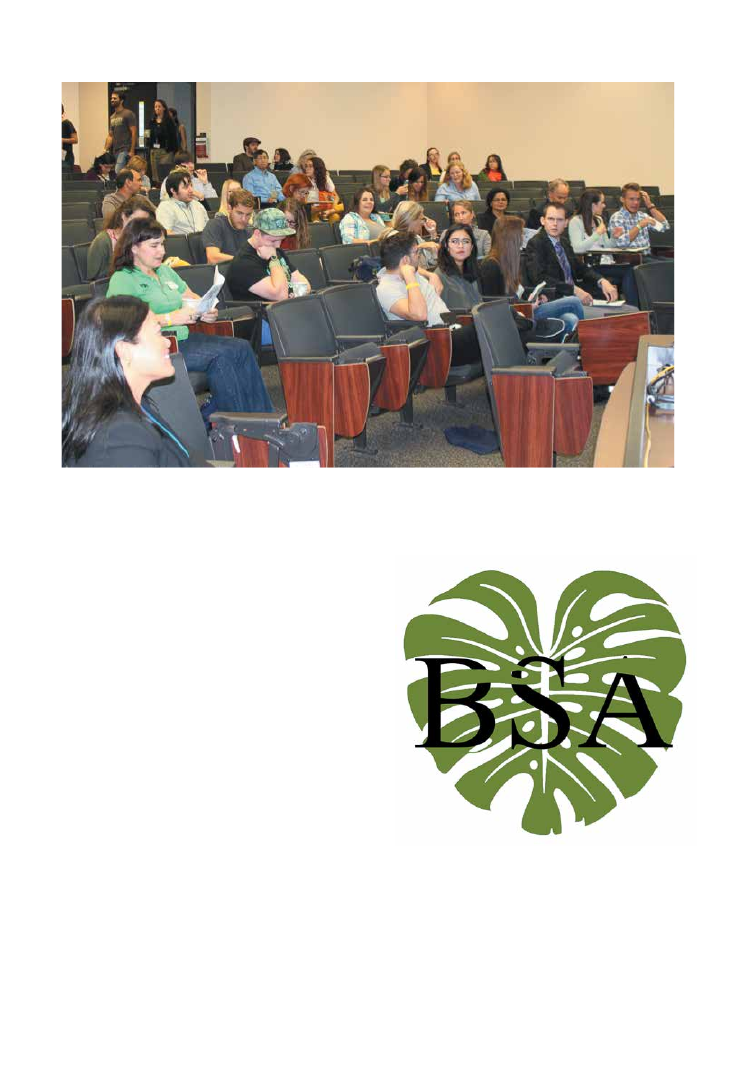
PSB 65 (1) 2019
54
chapter hopes to raise funds through plant
sales to help financially support attendance to
the BSA annual meetings as well as provide
small research grants. Although we both are
now pursuing botany at new universities, we
hope that this chapter will build a stronger
and more diverse botanical community at
UCF (Fig. 2).
Figure 2. The UCF Chapter’s BSA logo.
Figure 1. Students at the Plants Beyond Limits Symposium, 2017.

55
BOOK REVIEWS
Biogeography
Land Bridges ................................................................................................................................................................. 55
Ecological
Twilight of the Hemlocks and Beeches ........................................................................................................ 57
Economic Botany
Monsters Under Glass: A Cultural History of Hothouse Flowers from
1850 to the Present ............................................................................................................................................. 58
Care of the Species: Races of Corn and the Science of Plant Biodiversity .......................... 60
Food Crop Production by Smallholder Farmers in Southern Africa: Challenges
and Opportunities for Improvement ............................................................................................................ 61
The Ethnobotany of Eden: Rethinking the Jungle Medicine Narrative ........................................ 63
Korean Functional Foods: Composition, Processing and Health Benefits .............................. 64
Systematics
Aquatic Dicotyledons of North America: Ecology, Life History, and Systematics ................. 66
The Book of Seeds: A Life-size Guide to Six Hundred Species from
Around the World ................................................................................................................................................... 67
BIOGEOGRAPHY
Land Bridges
Alan Graham
2018, ISBN-13 9780226544298
Paperback, $50.00; cloth,
$150.00; 288 pp.
University of Chicago Press,
Chicago, IL
This year, Dr. Alan Graham
published his fourth book
on the vegetative history of the new world,
this time focused on the physical connections
that allowed for the migration of plants,
animals, and ultimately humans between
continents. Graham, Curator of Paleobotany
and Palynology at the Missouri Botanical
Garden, has spent most of his career studying
neotropical angiosperm species through the
Cretaceous and Cenozoic, and his expertise
on the subject is evident from the mere
breadth of information provided in this new
treatise on biogeography.
Land Bridges, clocking in at nearly 300
pages, is concise but dense, with an array
of descriptions, figures, and a hefty online
appendix. While the various lists don’t
quite make for easy fireside reading, they
do underscore the utility of the book as a
compendium for further furtive research on
the part of the reader. In the preface, Graham
notes that in a review for his previous book, A
Natural History of the New World, the writer
stated, “I found the numerous historical asides
and personal anecdotes distracting (although
to be fair I should acknowledge here that my
graduate students had the reverse reaction
and really enjoyed these parts).” The number
of anecdotes and stories were thus “…reduced
in the present text.” As a graduate student
myself, I offer the reverse critique (my only
one for the book). The few stories that Graham
does include are well-placed and told, such as

PSB 65 (1) 2019
56
the expeditions of Vitus Bering (for whom
the first land bridge discussed in the book
was given its namesake) and the death of
Alfred Wegener in Greenland (part of the
North Atlantic Land Bridge). As someone
who enjoys the storytelling aspect of science
communication, I keenly felt the lack of other
such stories and wish there’d been more.
For anyone considering purchasing this book,
I offer the following barebones summary and
description. According to Graham, the purpose
of his previous three books was to outline the
vegetation history and climate regimes of
new world plants through time, whereas this
book specifically tackles the subject of plant
migrations across land bridges, starting with
the advent of angiosperms in the Cretaceous.
He recognizes five such land bridges, each the
subject of its own chapter (with the exception
of Berengia, which has two chapters): the
Bering Land Bridge, the North Atlantic Land
Bridge, the Antillean Land Bridge, the Central
American Land Bridge, and the Magellan
Land Bridge.
Each chapter is broadly organized into sections
that deal with the physical description of each
geographic area along with the associated
climates, the historical geology with a special
focus on how and when each land bridge
formed and (in the case of some) eventually
sank or broke apart, the modern vegetation,
utilization of the land bridge by plants (a few
animals get honorable mentions), and a final
section on how humans used the land bridges,
if at all. While Graham discusses fossil plants
and their distributions throughout the text,
he includes a chapter toward the end on a
few case studies as an added bonus. Here,
the biogeographic history of several families and
genera (mostly angiosperms) is discussed at length.
Anyone who studies plant biogeography
should have a copy of this book. The condensed
and aptly summarized 100-million-year
geological history, the descriptions of current
day climates and ecosystems, the history of
floral migrations, and most valuable to the
researcher, a voluminous list of citations and
recommended reading make this an invaluable
tome for future research and investigation.
Graham puts it best in the book’s conclusion:
“It is a long way from the Arctic to the Antarctic,
and 100 Ma is a long time allowing for the
probable and the improbable to occur. During
this interval the Atlantic Ocean opened,
separating the New World from Africa and
Europe; mean annual temperatures varied by
3°–5°C in the tropics to 8°–15°C toward the
poles; the Rocky Mountains, Sierra Nevada,
and Andes Mountains rose; North America
was joined by South America via the isthmus
of Panama; the Gulf Stream strengthened,
bringing greater heat to the North Atlantic;
palms grew within the Arctic Circle; the
Amazon River reversed its course from the
Pacific to the Atlantic; South America and
Antarctica separated with formation of the
Magellan Strait, the Drake Passage, and the
Antarctic Circum-Current; glaciers formed,
plants disappeared, oceans cooled, and the cold
Humboldt Current flowing northward added
to the dryness developing along the west coast
of South America; sea levels rose and fell by
150 m, alternately inundating then exposing
coastlines and continental interiors; humans
crossed Beringia for the first time, moving
from Asia into North America; plants evolved
new ecological tolerances and pollination,
dispersal, and defense mechanisms; CO2
concentration varied from more than 1000
ppmv (or perhaps capped at 1000 ppmv…) to
less than 200 ppmv; and during all this time
land bridges were modifying atmospheric and
ocean circulation patterns and periodically
joining the New World to and separating it
from regions and biotas immediately adjacent
and far beyond.”
-Jerald B. Pinson, Department of Biology,
University of Florida, Box 118525, Gainesville,
FL 32611 USA

PSB 65 (1) 2019
57
ECOLOGICAL
Twilight of the Hemlocks
and Beeches.
Tim Palmer
2018. ISBN 9780271079530
Hardcover, $34.95; 171 pp.
Pennsylvania State University
Press, University Park, PA
It is very difficult to approach
writing about Twilight of
the Hemlocks and Beeches, because pondering
this topic is overwhelmingly sorrowful. The
book’s author and photographer, Tim Palmer,
is a visual and verbal storyteller whose craft
(this is his 27th book about the environment
and adventurous travel) changes readers’
understanding of the world. Here, he portrays
two calamitous events. The approaching end
to Eastern hemlock, a foundation species of
pristine North American forests, is under
threat now by the exotic invasive woolly
adelgid, Adelges tsugae. Beech trees are
likewise afflicted. Their disease occurs after
extensive bark invasion by the beech scale
insect, Cryptococcus fagisuga. Excessive
feeding introduces two fungal species of
Neonectria to produce annual cankers on the
bark of the tree. The continuous formation of
lesions around the tree eventually girdles it,
resulting in canopy death.
The book’s success in delivering his message
is the result of splendid photographs used as
a persuasive tool to deliver the conservation
lesson, conferring urgency to his work. As an
artist and photojournalist, he evokes sympathy
for the societal and spiritual as well as the
economic value of the trees he images. Palmer
makes superb use of photography’s potential
for combining poetry with phenomenological
accuracy to communicate the quality of place.
The author’s introduction conveys the essence
and feeling of the forest, using photography’s
potential for transmitting the symbolic
and experiential qualities of environmental
elegance; it “calls up a sense of reverence. In
the trees’ scented atmosphere, life is serene,
soothing, protected.” Combining poetry with
phenomenological accuracy, Palmer helps us
understand the relationship of hemlocks in
our environment: “My footsteps are muffled
by the softness of the needle-filled mattress
underfoot, giving extra spring to my stride.”
He also states, “I can imagine the earth before
we humans were born, a land governed by
itself in wildness beyond anything we now
know. Primeval.”
This study reveals Palmer’s unwavering
attachment to the topography and psychology
of landscape: his cherishing of unspoiled
lands. His photographs are tools punctuating
his remarks and attesting to the authenticity
of his perception. They augment the ability
of the written word to explain multiple layers
of cause, effect, and significance using the
evocative power of photographs to foster
empathy and appreciation.
Involving our emotions as well as our intellect,
Palmer’s unretouched 105 documentary
photographs force us to care about what has
been presented and potentially to act to prevent
their predicted demise, as he urges in the final
chapter (“Confronting Loss and Welcoming
Renewal’) by dual means: biological control
agents and chemical retardation. This volume
is a compelling visual testament by a talented
photographer that will appeal to many outdoor
enthusiasts, natural historians, ecologists, and
lovers of nature. Palmer’s photographs inform
us; they also touch our souls.
–Dorothea Bedigian, Research Associate, Mis-
souri Botanical Garden, St. Louis, Missouri

PSB 65 (1) 2019
58
ECONOMIC BOTANY
Monsters Under Glass:
A Cultural History of
Hothouse Flowers from
1850 to the Present
Jane Desmarais
2018. ISBN-13:
9781780239750
Hardback, £25.00; 248 pp.
Reaktion Books, London
“Monsters Under Glass”
by Jane Desmarais is a “cultural” history
reference book that covers the history of how
the fascination of exotics and tropical plants
became prevalent in many classic novels,
poems, and artwork. “Monsters Under Glass”
covers not only the historical fascination, but
also the rise of horticulture, horticultural
cultivation techniques, glass innovations, and
heating technologies. “Monsters Under Glass”
refers to the greenhouse as a “hothouse”—
hence, the historical background within
the book on the rise of glass innovation and
heating technologies as it plays a major role in
the rise of exotic flower fascination. Since the
cultivation of exotics outside the native region
requires specialized care, specifically, they are
best grown in a controlled environment that a
greenhouse can provide; exotics are otherwise
described as “hothouse flowers.”
Dating back to the early nineteenth century,
the fascination with the hothouse and
hothouse flower stimulated the imagination of
artists, novelists, poets, and citizens of the era.
Over about a 100-year span (1750 to 1850),
approximately 5000 or more species of exotic
plants were moved into England. A growing
appeal with exotic plants and the gardening
scene was first established and explored
by the wealthy-class citizens. Affordable
literature started to be published and public
hothouses and botanical gardens expanded
in cities across Europe, allowing middle-class
citizens to allure over the hothouse flowers.
The expansion caused innovations in glass,
in order to improve natural light inside
hothouses, and new heating technologies
permitted more even heating than the classic
wooden stove previously provided. Over time,
the rapid development of glass innovations
in order to improve horticulture techniques
moved away from being of avail to the wealthy
class. Although glass innovations were
moving at a significant rate, not everyone was
fond of this swift advancement. In fact, some
saw the glass innovations as only a modern
fad and unrefined; Edgar Allen Poe, a classic
American writer, stated that, “In the matter
of glass, generally, we proceeded upon false
principles. It’s leading feature is glitter….
unmeaning glass chandeliers, prism-cut, gas-
lighted, and without shade, which dangle in
our most fashionable drawing room, may be
cited as the quintessence of all that is false in
taste or preposterous in folly.”
From approximately 1850, increasing
references throughout artwork, poems,
and novels showed the captivation with
the hothouse flowers. The hothouse and
hothouse flower became powerful metaphors
throughout novelists’, poets’, and artists’
work that widely varied in interpretations.
Joel-Peter Witkins, a boundary-crossing
photographer who idealized nature, expressed
nature in the terms of beauty, sexuality, and
decay. Witkins claimed that he wanted to “live
in an age which sees similar beauty in a flower
and in the severed limb of a human being.”
Comparatively, H.G. Wells in his book “War of
the Worlds” used red weed to metaphorically
describe the dangers of colonialization. The
metaphorical aspect in “Monsters Under
Glass” shows how modern society draws on
the fascination of the nineteenth century and
hothouses, with coined terms like “intellectual

PSB 65 (1) 2019
59
hothouses.” Beyond the metaphorical aspect,
modern culture is just as fascinated with
hothouse flower growth as in the nineteenth
century. There is something gripping about the
phenomena of containing wild nature under
glass and the convergences of modern people
to the blooming of the giant Amorphophallus
titanium, better known as the corpse flower.
The corpse flower rarely blooms and admits a
stench that has been described as something
reminiscent on rotting flesh and/or excrement.
Despite the foul stench, large crowds gather to
watch this exotic bloom.
Many other modern culture aspects are rooted
deeply in this crazed nineteenth century
culture of corsages and perfumes. The wearing
of flowers (i.e., corsages) dates to the ancient
Persian era, but the nineteenth century led
to the exotic flower-wearing on the dandy
male figure. The wearing of flowers, better
described as a “flower fetish,” was a status
symbol of wealth, individualism, admiration,
and even homosexuality; carnations, violets,
gardenias, poppies, and orchids were favored
for flower-wearing. This “flower fetish” was
not only in relation to the wearing of flowers,
but also to the fixation with the fragrance
produced by flowers, which similarly dates
to the ancient Persian era. Throughout the
centuries, perfume was used to combat fatal
epidemic diseases such as the bubonic plague.
The inhalation of odors was believed to offer
protection against fatal epidemic disease,
and physicians would disinfect the homes of
the dead with strong scents and balms. The
odors ranged from mint, cedar apple, violet,
and roses. The nineteenth century was when
the perfume industry changed dramatically,
turning perfume into a luxury product that
presented one’s social standing and character.
The virtuous, wealthy, and women of good
taste wore scents that were floral and dainty,
as opposed to the courtesans and prostitutes
who wore scents that like jasmine (“musk
like”), which hinted toward lust and earthy
sexuality.
The association between social status and the
fragrance worn by a woman is part of the long
history of women symbolized by gardens and
flowers throughout the centuries, which has
appeared in classic artwork for interpretation
amongst art viewers. Symbolisms can be a
representation of a woman’s fertility, purity,
innocence, devotion, sexuality, and natural
beauty. Numerous types of flowers are within
classic artwork, but the most commonly used
over centuries is the rose and lily. The rose
is a signifier of women in multiple different
traditions, ranging from the standard symbol
of femininity to sensual sexuality. The lily, by
contrast, is represented as highly erotic and
the profligate behavior in women. The rose
and lily are representative of the sexuality
of women throughout the centuries, yet the
sexual connotations between these flowers is
highly variably.
“Monsters Under Glass” compartmentalizes
a long history into a short 217 pages while
captivating the readers interest throughout
its entirety. The author is a Senior Lecturer at
the University of London. “Monsters Under
Glass” is organized into 8 chapters, including
36 illustrations, 16 pages of references, and 6
pages of select bibliography.
--Erin Downey, University of South Florida

PSB 65 (1) 2019
60
Care of the Species:
Races of Corn and the
Science of Plant Biodi-
versity
John Hartigan, Jr.
2017. ISBN 978-0816685356
Paperback, $20.00; cloth,
$108.00. 376 pp.
University of Minnesota Press,
Minneapolis, MN
The title of this book, taken on its own, might
lead one to think that it is written by a biologist
and that it will give a scientific review of the
rich history of research on corn biodiversity.
This would be an erroneous assumption, as
this particular book explores the science of
biodiversity from a very different perspective:
that of cultural anthropology. Hartigan uses
the tools of ethnography to examine ideas of
race across species, the care of humans for
nonhuman beings, and how our ideas about
plants and diversity informs the way we think
about conservation.
It seems that Hartigan began this work with
the intent of doing an ethnography of the
scientists working on corn biodiversity, in
labs, botanical gardens, and seed banks. There
is a rich body of work in cultural anthropology
about scientists and the work of science, and
the author has added to it with his work here.
But somewhere along the path of the study,
his focus shifted, and he ends up applying
the tools and techniques of ethnography to
the plants themselves, rather than the people
studying the plants. In doing so, he raises
some fascinating questions and asks us to look
at plants differently even from how botanists
may see them.
Throughout this book, Hartigan “follows
the species” of corn as he visits laboratories,
seed banks, and botanical gardens in Mexico
and Spain where plant diversity is being
studied and/or preserved, interviewing the
scientists who work with the plants and
trying to understand how they view diversity
and species, how they study them, and
how they relate to them and care for them.
Hartigan begins this book with accounts of
visits to laboratories where corn genetics
and breeding is being studied in Mexico. He
explores conceptual questions such as: what is
a species? What is a “race” in corn? Are these
human constructions? What is the use or
value of these kinds of classifications? He also
considers anthropocentrism and how it affects
the ways these scientists think about and
interact with their subjects. In discussing the
concept of race as applied to plants, and how/
why this diversity has been preserved (or not),
he explores how the idea of racial identity as
applied to humans and corn is intertwined in
Mexico, and the problems with as well as uses
of racial thinking.
The second half of the book moves to Spain
where the author visits botanical gardens in
Madrid, Barcelona, and Valencia. This section
looks more broadly at how botanists think
about and relate to plants, and how gardens
make this accessible to the public. He talks
with the botanists there about the process of
classifying plants and how this affects their way
of seeing and paying attention to plants. He
explores broad questions such as: why do we
care about plants and their diversity? How do
we care for them or preserve that biodiversity?
How do people (other than botanists) interact
with botanical knowledge? For example, he
describes the markers naming and classifying
the plants in the gardens; the Spanish word
for these markers is “etiquetas,” emphasizing
the fact that these markers introduce visitors
to the plants, just as our interhuman etiquette
includes introducing each other in social
situations.
The final chapter of the book, “How to
Interview a Plant,” outlines exactly how
Hartigan approaches an ethnographic study

PSB 65 (1) 2019
61
of a non-human species, going through
step-by-step how one might “interview a
plant.” His approach brings to mind the great
botanist, P. Barry Tomlinson, who would
often answer students’ questions about plants
with the command, “Ask the plant!” In doing
so, he directed our inquiry away from other
scientists (who could be biased or flawed or,
at the very least, restricted in their views of
how plants work) and toward the organism
in question, looking for answers directly from
its biology. Hartigan approaches interviewing
a plant systematically in the same way he
would approach studying a particular human
cultural group, and asks himself and other
anthropologists as well as botanists: how
do I observe, describe, ask questions of a
plant? How do I apply the theoretical models
of cultural anthropology to a completely
different species? Essentially, this final chapter
describes the methodology that Hartigan
used in his studies of plants, developed after
immersing himself in the world and thinking
of botanists.
I am quite certain that, not being an
anthropologist, I have missed much of the
anthropological depth of this work, and I
can’t even pretend to share that richness with
you here. Instead, I offer the perspective of
a botanist looking back upon the work of an
anthropologist who studied botanists. I find
the perspective refreshing and fascinating,
even without the depth of context that an
anthropologist would bring to the reading.
Hartigan says in his introduction, “I hope the
reader will find on these pages a variety of entry
points for understanding plants and learning
to recognize them in the world around us.” I
think that he does this pretty well for those
who are not botanists, combatting just a
little the plant blindness we find so rampant
among our own species. For botanists, on
the other hand, he provides us with both an
anthropological view of our own kind as well
as a glimpse of how those outside our field
may receive our understanding of plants and
way of seeing them.
-Amy E. Boyd
Food Crop Production
by Smallholder Farmers
in Southern Africa: Chal-
lenges and Opportuni-
ties for Improvement
Ambayeba Muimba-Kankol-
ongo
2018. ISBN 978-0-12-814383-4
Paperback, $200.00. 368 pp.
Academic Press, Cambridge,
MA, San Diego, CA
Muimba-Kankolongo, whose career spans 30
years assisting small-scale farmers in central
and southern Africa, received his M.S. and
PhD degrees from Cornell University and has
been a contract instructor in the department
of biology and biochemistry at Carleton
University, Ottowa, Canada, and senior
lecturer in the department of environmental
and plant science, School of Natural Resources
at the Copperbelt University, Kitwe, Zambia.
His new textbook aims to fill a need for
smallholder farmers in southern Africa. The
volume opens with a sympathetic dedication
to his mother who, he reports, was unhappy
when he cleaned his plate, suggesting that he
hadn’t had enough to eat.
Following the author’s introduction, topics
covered include (1) Climates and agro-
ecologies of the regional economic Southern
African Development Community (SADC),
that region comprising Angola, Botswana,
DRC, Lesotho, Malawi, Mozambique,
Namibia, Swaziland, Tanzania, Zambia, and
Zimbabwe; (2) Factors important to crop

PSB 65 (1) 2019
62
describes improved agricultural production
technologies for ensuring adequate food
production.
Although all photographs are not credited,
numerous topical illustrations and a map
enrich the textbook considerably. Tables taken
from the U.S. Department of Agriculture
provide nutritional values, per 100 g raw
material of select local vegetables, including
cabbage and okra. The contents are broad
(i.e., include useful information, even about
crop origins and geographical distribution);
therefore, it should provide answers to most
basic student questions.
The foreword by Dr. S. Nteranya, Director
General, IITA, notes that this textbook was
inspired by lack of such a resource for the
Southern African region and includes the
expressed hope that the information will be
helpful to growers, research and extension
services, and students and professionals in
institutions of higher learning. He writes
that while agriculture is at the core of local
life, agricultural productivity for subsistence
farmers has always been very low because of
recurrent droughts, use of traditional farming
systems, and outbreaks of pests and diseases.
The book closes with a 14-page bibliography,
a 4-page glossary, and a 15-page index. Its cost
might be prohibitive, in terms of accessibility
for student-farmers, hence it may be better
described as a useful reference work.
–Dorothea Bedigian, Research Associate, Mis-
souri Botanical Garden, St. Louis, Missouri,
USA
production; (3) Crop diseases and pests; (4)
Smallholding farms; (5) Common cultivation
practices; (6) Pre- and postharvest field
operations; (7) Cereal production; (8) Root
and tuber crops; (9) Leguminous crops (beans,
groundnuts, Bambara groundnuts); (10)
Vegetable production (cabbage, okra, onion,
pepper, pumpkins, rape, tomato); (11) Fruit
production (banana, pineapple, sugarcane);
and (12) Perspectives for improvement
(seed quality, irrigation, storage structures,
improving extension services).
Food Crop Production evaluates traditional
cultivation practices used by smallholder
farmers, adding the latest information on
increasing crop yield through adoption of
innovative techniques. It catalogs smallholder
cultivation practices and recommends
strategies for improvement, including
management practices that reduce net carbon
emissions and technologies that improve soil
structures and conserve natural resources.
Some attention is given to empowering
women’s contributions along value chains and
urging government commitment to adopt
policies that enhance agriculture productivity
by encouraging farmers to use environmentally
sound cultivation technologies.
Muimba-Kankolongo’s specialty in plant
pathology is pervasive throughout the
textbook, in consideration of traditional
farming techniques that have often produced
negative impacts on the environment,
resulting in crop vulnerability. Pests and
diseases, weeds, and invasive plant species
put populations at risk of poverty, hunger,
and malnutrition. Food Crop Production

PSB 65 (1) 2019
63
The Ethnobotany of
Eden: Rethinking the
Jungle Medicine Narra-
tive
Robert A. Voeks
2018. ISBN: 9780226547718
Harcover, $45.00. 328 pp.
eBook ISBN: 9780226547855,
$10.00–$45.00.
University of Chicago Press,
Chicago, IL.
Robert Voeks, professor in Geography
and the Environment at California State
University, Fullerton, and the editor of the
journal Economic Botany, reverses some
romanticized notions about the profitable
healing plant resources of tropical rainforests
as “pharmaceutical factories.” Instead, Voeks
shows that the medicinal Eden manifests
its apothecary via a range of ruderal weeds,
dominated numerically by disturbance,
and pays homage to those folks whose
experimentation led to their discoveries as
nutrients and medicines.
Voeks’ analysis of tropical landscapes
exemplifies the diverse topics to be found
underneath the umbrella of the intersections
amongst anthropology, botany, history,
art, religion, and geography that form the
discipline called ethnobotany. His descriptions
are suspenseful, completely engrossing, to the
degree that I had difficulty putting the book
down. An example is his depiction of a secret
stash of prized coffee seeds that was presented
in a bouquet of flowers by the love-struck
wife of a governor of French Guiana, Madam
d’Orvilliers, to Brazilian sergeant Melo Palheta
upon his departure. Those beans whisked off
to Brazil were likely to have been the beans
that led to Brazil’s eventual global dominance
in coffee production, resulting in one of the
world’s first examples of biopiracy.
Voeks’ own fieldwork in the tropics of Borneo,
Brazil, and Mozambique provide firsthand
experience to tackle complex concerns
such as the contentious issue of intellectual
property, complicated by geography and
time, writing that “intellectual ownership of
botanical nature assumes many guises” (p.
116). As Voeks traces the colonial-era search
for medicinal plants, he busts, repeatedly, the
clichéd myth of the noble savage. Voeks views
plant species that maintain more than one
material value (e.g., as fiber and medicine or
fiber and food) as rare.
Voeks’ lively writing style deserves praise too;
notably, he can translate a biological process
having a formidable designation, into language
anyone can visualize. One example is this
vivid description of cryptogeal germination
using the “saxophone growth” metaphor:
“Like many other palm species, piassava
has the habit of sprouting immediately
and abundantly after a fire. This is due to
an unusual germination pattern, known as
saxophone growth (cryptogeal germination),
in which the terminal bud of the seedling
initially burrows down into the soil, rather
than reaching towards the sky. At about 20
cm in depth, it reverses course and pushes its
leaves above ground. As a consequence, if the
forest is cut and burned, the heart of the palm
(apical meristem) is protected under the soil
from the flames, allowing it to resprout a short
while later. This feature is key to understanding
how the species has been managed to the
present day. When the density of the palm
in an area is low, small patches of rainforest
are cleared, sparing only adult piassava. The
slash is allowed to dry, and then it’s burned.
Within a few weeks, a near carpet of piassava
seedlings emerge, having survived the heat of
the flames safely ensconced below the surface.
[.…] Saxophone germination in palms now
often points to deforestation and irrational
exploitation, with isolated and unreproductive
palms in pastures and farm clearings marking
“virtually dead” populations” (p. 40).

PSB 65 (1) 2019
64
Scrupulous scholarship is in evidence, with
42 pages of references, 5 pages of notes, and
the 18-page index, as well as the carefully
credited variety of maps, digital photos, and
illustrations. I observed only one spelling
error, “recurring them[e] in ethnobotany” (p.
133). Ethnobotany of Eden is a benchmark
contribution, with appeal to a wide audience of
scholars and general readers holding interests
in botany, conservation, tropical biology,
economic geography, and environmental
sciences.
–Dorothea Bedigian, Research Associate, Mis-
souri Botanical Garden, St. Louis, Missouri
Korean Functional Foods:
Composition, Processing
and Health Benefits
Kun-Young Park, Dae Young
Kwon, Ki Won Lee, and Sunmin
Park, Eds.
2018.
Hardcover, ISBN
9781498799652, $229.95. 564
pp.
eBook, ISBN 9781315156453, $206.96
CRC Press, Boca Raton, FL.
Food is one key element of culture that presents
opportunities for dissemination of cultural
information. A recent title in the CRC Press
series, Functional Foods and Nutraceuticals,
features the health benefits and processing
methods of Korea’s major fermented foods
such as kimchi, soybean paste, and red pepper
paste, consumed with the traditional Korean
dish, bibimbap. Korean Functional Foods
serves as an essential scholarly resource,
introducing readers to Korean culinary
history since antiquity, including a focus on
early myths.
The first chapters offer reviews of Korean food
history, culture, and characteristics. Koreans
have created unique preparations as well as
a food culture that is fundamentally distinct
from Chinese or Japanese. Among their
basic ingredients is bap, warm cooked rice,
topped with small amounts of condiments
(fermented side dishes and raw or broth-
cooked vegetables and mushrooms), creating
the colorful dish called bibimbap. The
combination of vegetables, rice, fermented
sauces and optional animal protein provides a
balance of nutrients, rich in fiber. The primary
cooking oils are from sesame, for its distinctive
nutty aroma, and perilla.
Quintessential among Korean staple
fermented foods is kimchi, a lactic acid
bacteria fermented vegetable mixture.
Although dozens of variations exist, the key
ingredients of kimchi are Napa cabbage and
radish, spiced with ground red pepper, garlic,
ginger, and green onion, added to improve
flavor, nutrition, and functionality. Kimchi
decreases the pH of the colon environment,
helping to maintain good colon health. Used
for centuries as folk medicine, the investigated
benefits of kimchi include antioxidant and
antiaging, antimicrobial, antimutagenic and
anticancer, anti-inflammatory alleviation of
atopic dermatitis-like symptoms, anti-obesity,
and cholesterol- and lipid-lowering effects.
This volume contributes to a rapidly growing
body of literature covering the role of
plant secondary metabolites in food and
their potential effects on human health.
Consumers, increasingly aware of diet-related
health problems, seek natural ingredients
that are safe, health-promoting nutraceutical
components, including dietary fibers,
phenolics, antioxidants, antimicrobials, and
bioactive compounds. The healing properties
of ginseng, vinegars, and spices including red
pepper, ginger, garlic, black pepper, mustard,
and sesame are evaluated herein.

PSB 65 (1) 2019
65
The editors provided a valuable service by
assembling an extensive literature that will
benefit
researchers with interests in public health,
preventive medicine, dietetics, and nutrition.
As is often the case with edited works,
contributions are uneven, and there is a
little duplication among chapters. Various
assertions are outmoded; for example,
although the axiom “Let food be thy medicine
and medicine be thy food” is often attributed
to Hippocrates as it is here, scholars no longer
credit him. It seems that several chapters were
written awhile before publication, because
some information is not current; specific data
are misleading (e.g., world crop production
figures rely on a reference from 2005, rather
than statistics that are updated annually).
Many of the citations quoted in each chapter
appear to be sourced from Korean, Japanese,
and other Asian authors; therefore, relevant
literature by other scientists might have been
missed. In that spirit, it seems useful to correct
the peculiar opening sentence of chapter 12
about sesame, positing that “sesame originated
in Africa (or some species from India)”.
Genetic, phytochemical, and molecular
data amassed during four decades provide
ample evidence that the crop species sesame
(Sesamum indicum L.) was domesticated on
the Indian subcontinent (Bedigian 1984, 2000,
2003, 2007, 2011, 2014, 2015; Bedigian et al.,
1985; Gormley et al., 2015).
–Dorothea Bedigian, Research Associate, Mis-
souri Botanical Garden, St. Louis, Missouri,
USA
LITERATURE CITED
Bedigian, D. 1984. Sesamum indicum L. Crop ori-
gin, diversity, chemistry and ethnobotany. Ph.D.
dissertation, University of Illinois, Urbana-Cham-
paign. University Microfilms DA8502071, Dis-
sertation Abstracts International 45, 1985: 3410-
B.
Bedigian, D. 2000. Sesame. In K.F. Kiple and
C.K. Ornelas-Kiple, Eds. The Cambridge World
History of Food, Vol. I, pp. 411-421. Cambridge
University Press, NY.
Bedigian, D. 2003. Evolution of sesame revisited:
domestication, diversity and prospects. Genetic
Resources and Crop Evolution 50: 779-787.
Bedigian, D. 2011 [2010]. Cultivated sesame,
and wild relatives in the genus Sesamum L. Pag-
es 33-77. In D. Bedigian, Ed. Sesame: the genus
Sesamum. Medicinal and Aromatic Plants - Indus-
trial Profiles series. CRC Press, Taylor & Francis
Group, Boca Raton, FL.
Bedigian, D. 2014. A new combination for the In-
dian progenitor of sesame, Sesamum indicum L.
(Pedaliaceae). Novon 23: 5-13.
Bedigian, D. 2015. Systematics and evolution in
Sesamum L. (Pedaliaceae), part 1: Evidence re-
garding the origin of sesame and its closest rela-
tives. Webbia: Journal of Plant Taxonomy and
Geography 70: 1-42.
Bedigian, D., D. S. Seigler, and J. R. Harlan. 1985.
Sesamin, sesamolin and the origin of sesame. Bio-
chemical Systematics and Ecology 13: 133-139.
Gormley, I. C., D. Bedigian, and R. G. Olmstead.
2015. Phylogeny of Pedaliaceae and Martyni-
aceae and the placement of Trapella in Plantagina-
ceae. Systematic Botany 40: 259-268.

PSB 65 (1) 2019
66
SYSTEMATICS
Aquatic Dicotyledons of
North America: Ecology,
Life History, and System-
atics
Donald H. Les
2018. 978-1482225020
Hardcover: $221.00 US; 1334
pp.
CRC Press (Taylor & Francis),
Boca Raton, USA.
Because of their high productivity and
essential role in filtering the ecosystem’s
water supply, wetlands are a central focus of
ecological research and conservation efforts.
To varying degrees, the plant components
of their diverse communities are adapted
to aquatic conditions, with submerged,
emergent, free-floating, or suspended life
forms found among fully aquatic species,
while many other less specialized wetland taxa
range widely in their tolerance of inundated
conditions. Focusing on dicotyledonous
plants considered obligatorily aquatic (i.e.,
requiring water to complete some essential
stage of their life history), this authoritative
book offers an encyclopedic compendium of
their essential characteristics, ecology, and
biosystematic position. It is not a guide for
identification; there are no keys, photographs,
or figures besides cladograms. Once the
plants in question are identified, however, this
work will serve as an essential reference on
their backgrounds, distribution, community
associations, phylogeny, and uses.
The book is organized taxonomically,
using a recent Angiosperm Phylogeny
Group classification scheme. Here the
term dicotyledon simply refers to all non-
monocot flowering plants, devoid of its
former biosystematic status but evidently still
useful. No reason is stated for excluding the
monocots, which are major components of
aquatic communities, but one can surmise that
another volume as enormous as the present
one will be needed to treat them. Introductory
information is given for families and genera
that include aquatic species, and recent
cladograms are provided wherever available,
with aquatic taxa highlighted. Generic
entries include etymology, synonymies,
distribution, and species diversity (both
globally and in North America), habitat
characteristics, key morphological traits, life
history details, and general biological and
ecological characteristics. This is followed by a
description of each relevant species, with their
specific habitat preferences and ecological
details. Included are lists of reported plant
associates, sometimes extending to a half-
page or longer, as well as known interactions
with other kinds of organisms whose full
taxonomic affinities are provided. Additional
information on economic importance and any
known medicinal or traditional uses are also
given. Literature citations appear at the end of
each genus entry. The list of cited references
at the end of the book occupies almost 200
pages.
It is hard not to be impressed by a work of this
magnitude and the sustained effort involved
in assembling it. Aquatic Dicotyledons of
North America appears destined to become
an indispensable reference for almost any
study of wetland plant communities on our
continent and beyond.
-William B. Sanders, Florida Gulf Coast Uni-
versity

PSB 65 (1) 2019
67
The Book of Seeds: A
Life-size Guide to Six
Hundred Species from
Around the World
Smith, P. (editor)
2018. ISBN-13: 978-0-226-
36223-6 (cloth), 978-0-226-
36237-3 (e-book)
Cloth, US$55.00; E-book,
US$44.00; 656 pp.
The University of Chicago
Press, Chicago, IL
Weighing in at nearly 2½ kg, The Book of
Seeds contains actual- and magnified-sized
illustrations of seeds from a taxonomic
spectrum of 600 wild and cultivated species
from around the globe. The high-quality
images allow a reader to appreciate the
intricacies of seed morphology—from the
spiky surface of Silene dioica to the fiber
network of Telfairia pedata. The bright
red of Abrus precatoris seed or the mottled
appearance of Ricinus communis seed leap
from the page. The actual size of Vanilla
planifolia seeds is so tiny that multiple seeds
about the size of a dime need to be shown in
contrast to Lodoicea maldivica seed that spans
the bottom of 1½ pages—and this only shows
the top-most part of the seed. From the two-
horned seed of Trapa natans to the black-hair
covered seed of Protea cynarioides, I believe
a reader will be enthralled at all the textures,
colors, sizes, shapes, and appendages of seeds
that this book captures.
The heart of the book—covering about 95% of
the 656 pages—is devoted to the seed guide.
One species is covered per page. A world
map with the geographical range, colored
images of the seed, and a line drawing of the
plant are shown for each species. Across the
top of the page, the plant family, distribution,
habitat, dispersal, conservation status, trivia
notes, and seed size are provided. The text
is arranged in three short sections. The
first contains information on the plant—its
size, description, and uses—and the second
covering similar species. The third section
includes a mixture of data related to seeds
and their production for the species (e.g.,
pollination, fruit structure, dispersal, moisture
relations, and germination).
The other 5% of the book has introductory
material and chapters devoted to seed
biology (anatomy, morphology, dormancy,
and longevity), seed plant evolution, seeds
and humans, seed conservation (collection,
storage, and germination), and the importance
of plant diversity. Each of these chapters
covers the relevant information in succinct
detail. At the end of the book, a reader will
find a glossary, list of resources, notes on
the editor and five contributors, and two
indexes—one with common names and the
other with scientific names.
Without dwelling on every little detail, let
me provide some examples of areas that I
think the book could have been improved.
Providing sources would have clarified
information provided in the book. I realize
that a popular book shouldn’t overburden a
reader with references. However, I assumed
that the conservation status for each species
was from the IUCN. I guess this was correct
since very few inconsistencies occurred
(e.g., Pterocarpus santalinus listed as Near
Threatened and not as Endangered). Are
seeds of Oenothera caespitosa and Dionaea
muscipula bird dispersed? I searched in
vain for literature but could not find any
information to support these claims.
A reader needs to be careful with the
geographical ranges of species given in the
book. Some species have a narrower range
than indicated in the book (e.g., Jatropha

PSB 65 (1) 2019
68
gossypiifolia grows only in Florida (not
throughout North America) (USDA Plants,
https://plants.sc.egov.gov/java). The ranges
of other species are wider than indicated
(e.g., Fragaria virginiana and Oxalis violacea
occur throughout all or most of the United
States, not only the Midwest). Naturalized
ranges for some species are provided (e.g.,
Ligustrum sinense, Nepeta cataria), but those
for other species are not (e.g., Daucus carota,
Lactuca sativa). Some distributions are easily
missed due to their extremely small size (e.g.,
Alluaudia procera). I would have placed an
arrow to draw attention to the area.
Unfortunately, some statements on seed
dormancy are misleading. The book states
that “… it is only the weathering of the seed
coat … or by passing through the gut of an
animal” that allows physical dormancy to be
broken. On the contrary, this dormancy is
also overcome by fluctuating temperatures,
drying, fire, and winter temperatures. For
physiological dormancy, “… seeds require
cold temperatures [cold stratification] to break
down inhibiting chemicals before they can
germinate.” On the contrary, this dormancy
is overcome by changes in hormones and the
“push power” of the embryo.
I would recommend a few other changes in
future editions of the book. While the fruits
for some species are shown (e.g., Persea
americana, Aesculus hippocastanum, Punica
granatum), adding images of the distinctive
fruits or structures for the Mickey Mouse plant
(Ochna kirkii), sausage tree (Kigelia africana),
and rambutan (Nephelium lappaceum) would
be appreciated. For clarification, I would
identify all of the structures on the bean seed
figure (p. 10) similar to the corn seed. Also,
I would additionally label the hypocotyl and
radicle (or simply embryo) on both the bean
and corn seed. The graph on p. 27 needs
clarification since no y-axis label is present;
does the graph show documented uses among
all species or only those that are faced with
extinction?
Laying aside these criticisms, did the book
accomplish its purpose in providing a
snapshot of the incredible diversity of seeds?
The answer: a resounding yes! I thoroughly
enjoyed going through the book and
reminding myself of this great diversity.
–Jeffrey L. Walck, Department of Biology,
Middle Tennessee State University, Murfrees-
boro, Tennessee, 37132

Plant Science Bulletin
The Botanical Society of
America is a membership soci-
ety whose mission is to: pro-
mote botany, the field of basic
science dealing with the study
& inquiry into the form, func-
tion, development, diversity,
reproduction, evolution, & uses
of plants & their interactions
within the biosphere.
ISSN 0032-0919
Published quarterly by
Botanical Society of America, Inc.
4475 Castleman Avenue
St. Louis, MO 63166-0299
Periodicals postage is paid at
St. Louis, MO & additional
mailing offices.
POSTMASTER:
Send address changes to:
Botanical Society of America
Business Office
P.O. Box 299
St. Louis, MO 63166-0299
bsa-manager@botany.org
The yearly subscription rate
of $15 is included
in the membership
Address Editorial Matters (only) to:
Mackenzie Taylor, Editor
Department of Biology
Creighton University
2500 California Plaza
Omaha, NE 68178
Phone 402-280-2157
psb@botany.org
Plant Science Bulletin
Spring 2019 Volume 65 Number 1
BOTANY 2019
HEADLINERS!
Plenary Speaker
Stephen Pyne
Fire's American Century
Regional Botany Special Lecture - Tom Devender
Enhancing Diversity Luncheon Presentation - Tom Antonio
Incoming BSA President - Linda Watson
Incoming ASPT President - Pamela Soltis
Register Now - Don't Miss Out!
www.botanyconference.org

Plan your Botany Summers
Now!
Botany 2019
Tucson, Arizona
July 27 - 31, 2019
Botany 2020
Anchorage, Alaska
July 18 – 22, 2020
Fire and Ice!
Plan your Botany Summers
Now!
Botany 2019
Tucson, Arizona
July 27 - 31, 2019
Botany 2020
Anchorage, Alaska
July 18 – 22, 2020
Fire and Ice!